Rationing Christmas: When Americans Had Money, But Nothing to Spend It On
1942 would have been a great Christmas, if it hadn’t been for the war.
Unemployment had dropped to 4%. Just nine years earlier it had been 25%, and the average annual income was $5,133. Now it was $9,900. And with the demand for workers in defense plants, many women had become breadwinners, supplying households with two paychecks for the first time.
Americans had never seen such prosperity. But of course, any pleasure they might have felt was dimmed by their worries about the war, and about relatives and friends whose lives were at risk every day.
Moreover, despite the economic boom, the holiday season was affected by new shortages. Ironically, a generation where many had grown up impoverished now had the money to buy the food and luxuries they wanted — but much of what they wanted was in short supply, rationed, or just not being sold.
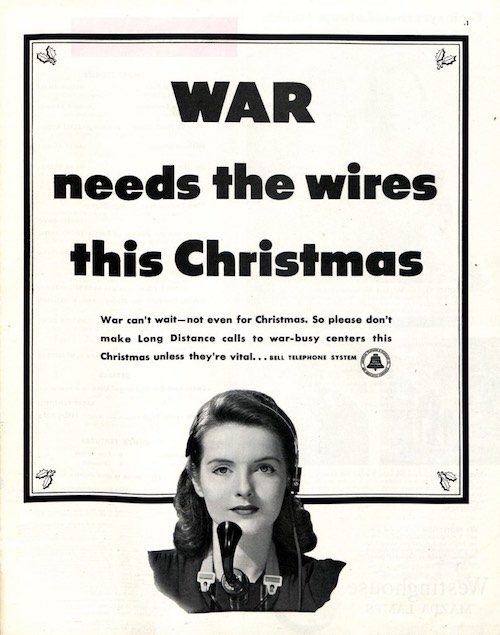
Click to Enlarge
Here were a few items people had to go without:
Christmas cookies
Butter was in short supply and sugar rationing limited consumers to a pound of sugar every other week, which cut into Christmas treats.
Cigarettes
In 1942, the average American smoked a pack of cigarettes a day. But now a third of American cigarettes had been requisitioned by the armed forces. Smokers were often confronted with “No Cigarettes” signs in stores.
Coffee
The Office of War Production began coffee rationing in November of 1942. Americans could only purchase one pound of coffee every five weeks. For some, this was a third of their normal intake. And this was in a time when average coffee consumption was twice what it is today.
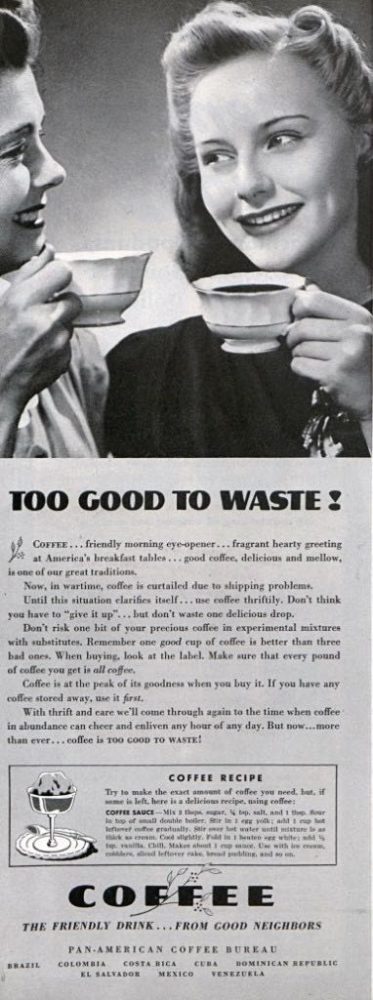
Click to Enlarge
Food
Consumers could only buy 2.5 pounds of red meat per week. Turkey, being a white meat, wasn’t rationed, but could be hard to find since the military requisitioned most of the country’s supply to provide turkey dinners for Christmas. In fact, because of hoarding, stores had trouble keeping all sorts of food, even items that weren’t rationed, available. Some stores themselves began rationing canned goods to prevent hoarding.
Travel
Starting in December of 1942, most motorists could only buy four gallons of gas a week. That limited family travel to approximately 68 miles a week, which might not have gotten them to Grandma’s and back at Christmas. People could still travel by train, but seats were limited because the railroads gave priority to military personnel.
Gifts
Store shelves weren’t exactly crowded that Christmas season. The big names in watches, radios, and other appliances were mostly producing military equipment. Other manufacturers could only get enough metal for limited production of gift items. Even simple items like bobby pins were hard to find. Consumers couldn’t even buy metallic tubes of toothpaste without first returning their old tube. Paper was also limited, which meant fewer books and magazines. Even clothing was in short supply. To conserve fabric, the War Production Board prohibited the sale of pleated skirts for women and double-breasted suits and vests for men.
Toys
Toymakers couldn’t obtain the metal and rubber they normally used, so they improvised. They made dolls, trucks, airplanes, and construction sets from cardboard, or experimented with the new plastics. The Treasury Department acknowledged the toy shortage, but recommended that parents buy their kids War Bonds, which were, of course, in plentiful supply. Many parents made toys out of household materials, or cleaned up recycled toys shared by other parents.
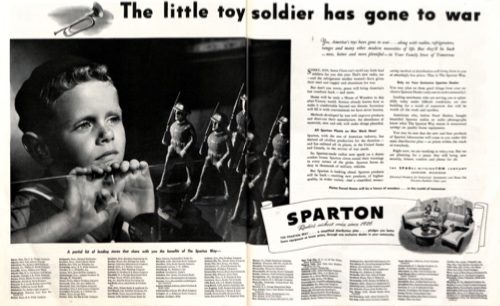
Click to Enlarge
But Americans adapted to shortages. They found renewed pleasure in crossword puzzles, cooking, and parlor games. Women revived their sewing and dressmaking skills. As one historian wrote, Americans of 1942 “got to know their neighbors better. Social life improved noticeably. Pleasures became simpler and less frantic.”
Is Christmas Too Religious?
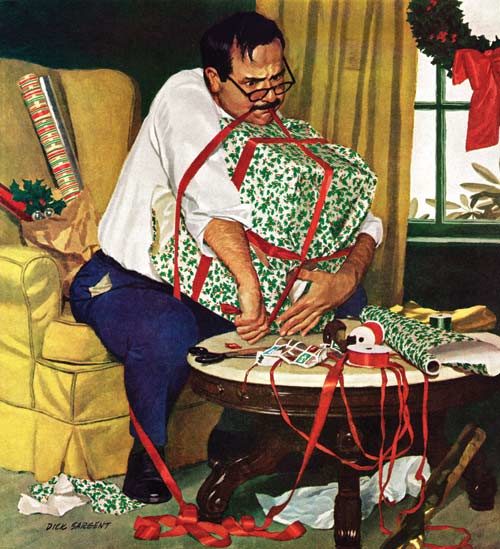
Post editors argued that we were taking the holiday way too seriously 50 years ago.
This editorial originally published December 16, 1967, as “God Rest Ye Merry”.
It is everyone’s privilege, of course, to celebrate Christmas in his own way. To some it is primarily a religious event; to others a completely secular holiday. Some regard it as a festival, others as a nuisance. Still others, not satisfied with celebrating it in their own way, annually complain at the way others celebrate it. Among these would-be legislators are those who denounce “commercialization,” those who drive around with signs that say, PUT THE CHRIST BACK IN CHRISTMAS, and those who enter into litigation about hymns and creches in the schoolroom. To these we add the voice of the former Father James Kavanaugh, who argues on page 10 of this issue, that the religious symbols of Christmas “no longer speak to me,” that “most of the past symbols are dead and the future ones have only begun dimly to live.”
Why so serious? Christmas, to begin with, is scarcely a Christian holiday at all. There is certainly no evidence that Christ was born on that day, nor was the day celebrated as such for some 300 years after His death. Instead, there were various festivals commemorating the winter solstice on December 21, and December 25 was officially decreed to be the birthday of the Unconquered Sun, climaxing the orgiastic week of Saturnalia. Teutonic and Celtic tribes added the rites of the Yule log, and the Christmas tree apparently dates from a fir tree planted by St. Boniface to replace the sacred oak of Odin in eighth-century Germany. Added to all this, from various places in various times, came Santa Claus, Good King Wenceslaus, and the office Christmas party.
It is, in short, a day of festivity and celebration, and everyone is free to celebrate whatever concerns him most, whether it be the coming of Christ or the coming of a new pair of skis. Far from “commercializing” Christmas, the merchants who sell Christmas presents, and the buyers who wrap them up and send them to one another, represent a tradition of Christmas gift-giving that is far older than its religious tradition.
And where’s the harm? It’s true that it can be annoying to have to stand in line to buy a teapot for Aunt Mathilda, and to receive, in return, a beige sweater in a size that hasn’t fit for 10 years. It’s true that after a certain number of Christmas cards have been sealed, the tongue begins to feel like a glue-factory washrag. It’s true that the bills that begin pouring in during January make one feel as though one were single-handedly buoying the national economy. Still, if there are excesses, they are excesses of giving, and while every gift may not be the purest expression of altruistic love, a dutiful gift is better than no gift, a routine card of greetings better than no card. Was it not George Bernard Shaw who responded to that foolish old saying about the impossibility of forcing people to be good by declaring that nobody was ever made good in any other way?
The more important part of Mr. Kavanaugh’s complaint deals not with commercialism, however, but with the decay of Christian symbols, and his argument reflects an increasing sense among many devout Christians that the rituals of the church have become meaningless. Behind this sense of meaninglessness lie two assumptions. The first is the assumption that such symbols as the cross or the lamb or the key or the dove once did have a meaning greater than they have today. The second is the assumption that the supposed loss of meaning is the fault of the symbol, or of the use of symbols. Neither assumption is indisputable. One suspects instead that they express a new version of the old cry, “Lord, I believe; help thou mine unbelief!”
Symbols are symbols because they express the inexpressible. Thus the lamb. Words are equally symbols. Thus the lamb is not a small white animal, but Agnus Dei qui tollis peccat mundi, and when, in search of clarification, we translate that into English, we risk a loss of meaning rather than a gain, for we risk a transformation of the magical into the mundane. Symbols do not die; what dies is our ability to use them as substitutes for reality. And in the demand for new symbols lies the hope of somehow making religion easy, the hope of somehow making it God’s duty to take part in our daily lives, rather than our duty to seek Him.
One of the curiosities of Mr. Kavanaugh’s argument is that his search for a more truly Christian Christmas leads him to a much more secular Christmas. And perhaps the only conclusion to be drawn from this is that the true meaning of Christmas can be experienced just as well in secular as in religious terms. It is, as stated in the beginning, a matter for each of us to determine for himself.
Cartoons: No Caption Required
A picture is worth a thousand words, they say. They must be right because these cartoons require no captions.
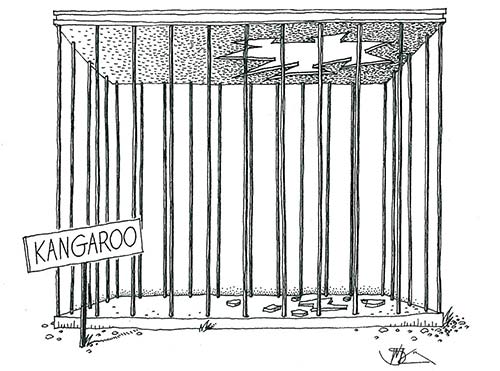
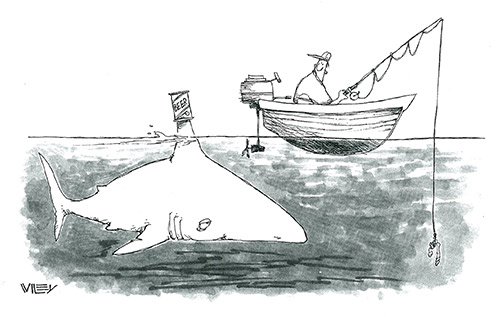
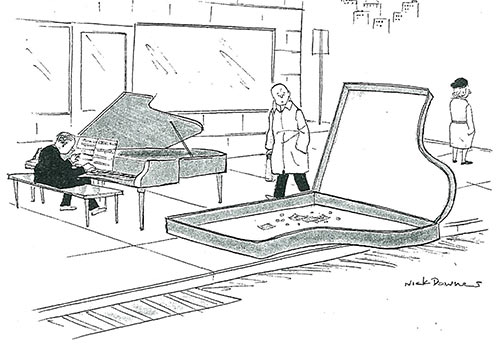
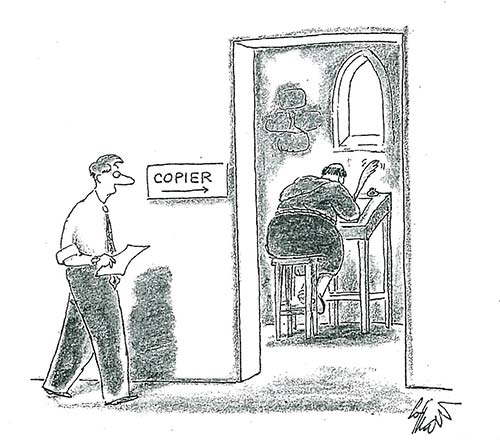

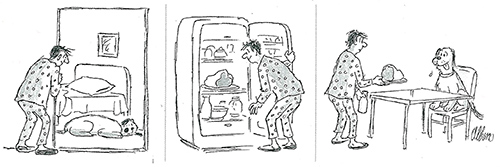
Vintage Ads: Classic Christmas Toys
Toy ads have always been a December fixture in the Post. Check out these vintage ads for train sets, baby dolls, shiny new wagons, and more.
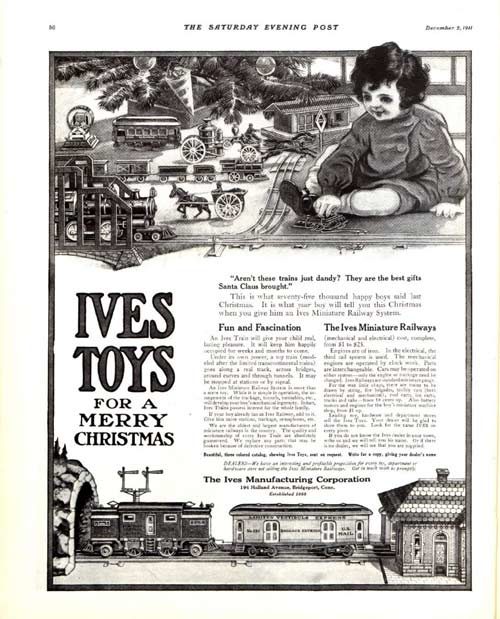
December 2, 1911
Click to Enlarge
The Ives Manufacturing Corporation made toy trains from 1868 to 1932. For decades, Ives made clockwork trains, but created its first electric train in 1910.
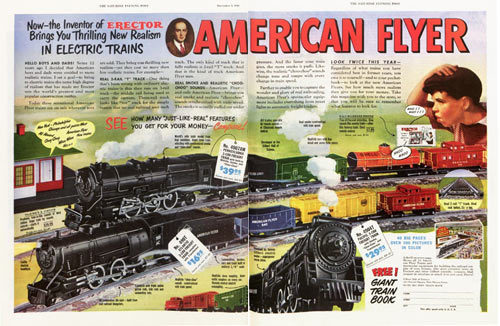
December 3, 1949
Click to Enlarge
These three-car trains were as realistic as could be, with a 2-rail track, puffing smoke, and actual “choo-choo” sounds. But the price would set you back: the Pennsylvania model was $39.95, which would be more than $400 today.
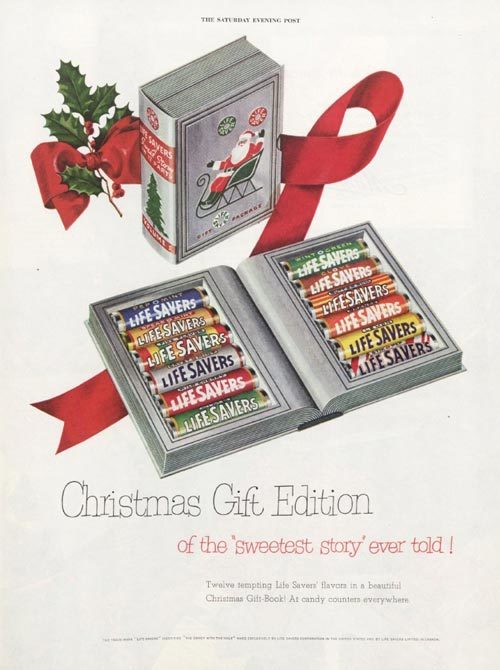
December 8, 1951
Click to Enlarge
Life Savers were invented in 1912 as the meltless summer mint with a hole in the middle. The five-flavor pack was introduced in 1935, and the Christmas Gift-Book made its debut soon thereafter. For many kids, it was the go-to Secret Santa gift, because who didn’t love Life Savers?
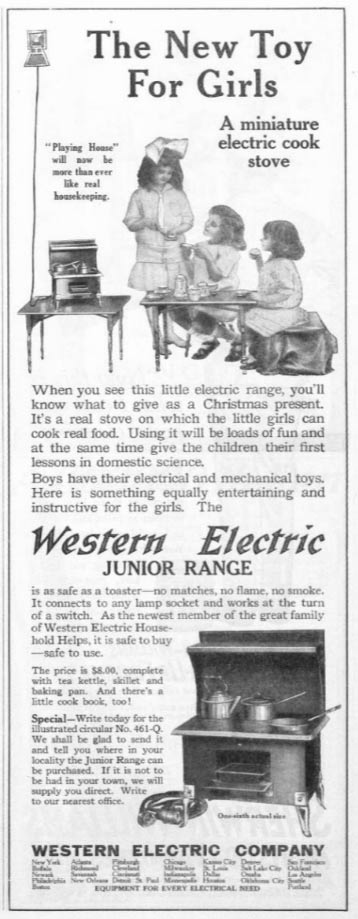
November 6, 1915
Click to Enlarge
This toy promises that “using it will be loads of fun and at the same time give the children their first lessons in domestic science.” Of course, it was meant for girls only.
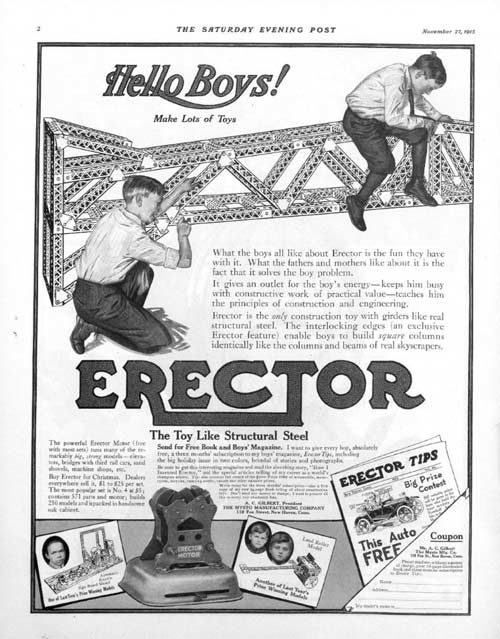
November 27, 1915
Click to Enlarge
Erector advertised its toy as one that “solves the boy problem,” giving him “constructive work of practical value.”
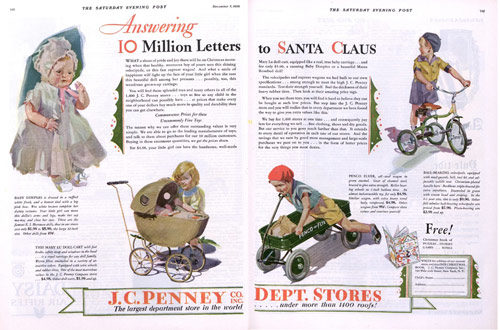
December 7, 1929
Click to Enlarge
This ad appeared just a month after the great stock market crash on October 29, 1929. Note that J.C. Penney emphasizes their better prices to reassure customers that they were getting a good value.
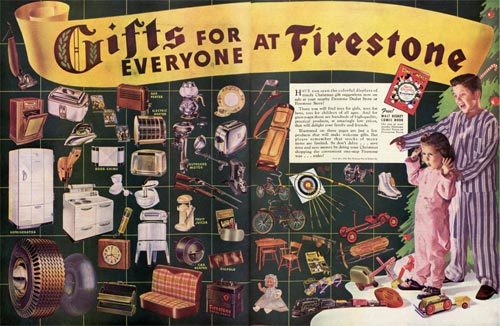
November 30, 1946
Click to Enlarge
For many years, Firestone stores sold more than tires. At least at Christmastime, one could purchase not only appliances large and small, but also books, toys, and sporting goods.
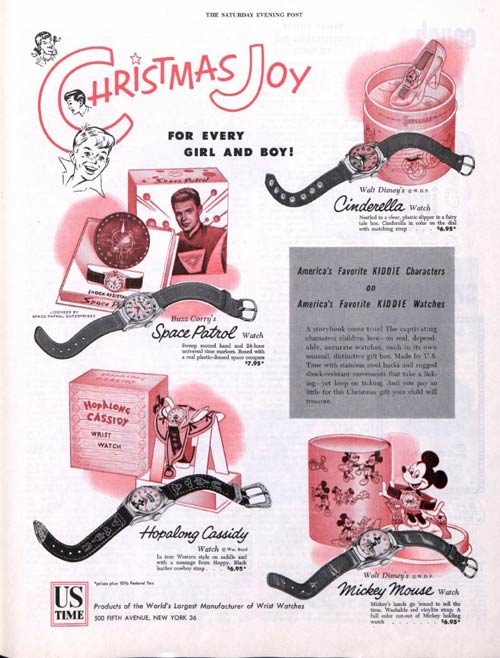
November 30, 1946
Click to Enlarge
This company eventually changed its name to Timex, but in 1953, they were already boasting that their watches could take a licking and keep on ticking.
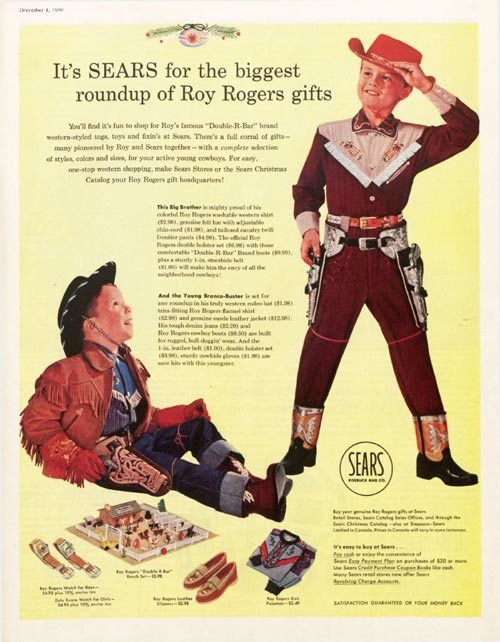
December 1, 1956
Click to Enlarge
Roy Rogers was one of the biggest Western film stars in the 1940s and ‘50s, and if you wanted to dress like him, Sears would oblige. Items included shirts, hats, boots, belts, jeans, gloves, watches, slippers, pajamas, and even a fringed jacket.
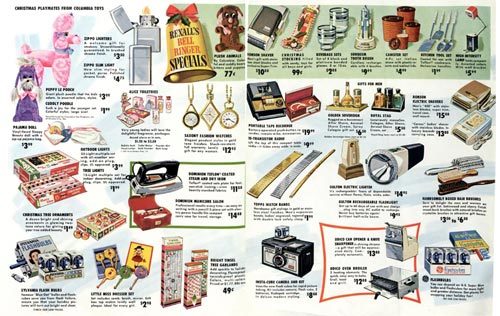
December 3, 1966
Click to Enlarge
Many-a-child (or panicked parent) will remember sprinting into the local drug store for last-minute Christmas presents for loved ones. Whether you were shopping for a Royal Stag cologne set, Insta-Cube camera, or portable tape recorder, you’d find it at Rexall’s. (But please, please don’t buy anyone an iron for the holidays.)
North Country Girl: Chapter 28 — The Age of Aquarius Comes to Duluth
For more about Gay Haubner’s life in the North Country, read the other chapters in her serialized memoir. The Post will publish a new segment each week.
I didn’t tell Doug Figge about Wendi Carlson’s advice, that the key to enjoying sex is more sex. I didn’t have to. His mind was on the same track, the only track 17-year old boys’ run on, the track with the thundering locomotive of sex hurtling along, blowing all other thoughts away.
The day after the first man landed on the moon and I gave up my virginity, Doug called with the woeful news that Joe Sloan had emerged from his basement with powder burns and a singed shirt, accompanied by a powerful stink of cordite. His parents decreed that their house, including those forgotten bedrooms, was off limits.
Doug knew it was one of my mother’s class days. “Please, please,” he begged. “Let me come over. It will be okay, we’ll be quick,” he said as if that were a selling point. “Fine,” I sighed.
One of the things I learned from my first experience was that sex was messy, and should not take place on my mother’s ivory brocade French Provincial couch. Doug pulled into my driveway, I let him in the backdoor, and hurriedly escorted up him to my bedroom.
It was the middle of the afternoon and the sun streamed through my windows. I was shy about taking off my clothes in the summer glare, and not especially looking forward to seeing my fairly unattractive boyfriend naked either. I turned my back, stripped and slipped between the sheets, and there was Doug, nude and on top of me and ready.
I thought we were safe. My mother usually wasn’t home till three. But some vagary of the University of Minnesota’s college calendar or maybe the excitement of the moon landing had caused my mother’s class to be canceled that day. I heard a familiar car pull up to the house and thought “This is bad this is bad this is bad,” and tried to shove Doug off me. His eyes were squeezed shut, beads of sweat popping out on his wispy moustache; he was oblivious. “Doug Doug Doug,” I whispered hoarsely, as I heard the house door open and not only my mother’s voice, but my sisters’ as well. I pushed him harder and finally got him off me and he realized that my mother was home.
As Doug’s Corvair was in the driveway, my mother knew we were in the house alone, which she had strictly forbidden fearing exactly what had come to pass. Before Doug and I had a chance to find even our underwear, my mother flung open my bedroom door and lost her mind. She didn’t know whom to hit first. She whacked Doug about the head a few times, as he tried to find his jeans, the hell with his briefs, then she turned on me, as wordless as a banshee, unable to articulate what she had seen with her own eyes: her fifteen-year-old daughter having sex. I burst into tears and Doug made his escape.
That event is burned into my memory with almost a physical pain. I can feel the warm air coming in through the windows, pushing the sheer white curtains into the room. I can hear the torrent of my mother’s shrieks, and my entire body burning and blushing and trying to vanish into thin air. Out of the corner of my eye, while trying to duck my mother’s roundhouses, I see a blur that is Doug, holding his shirt and shoes, rushing down the stairs and out of my life.
A sadder but wiser fairy had come to undo one of my wishes, a wish that had gone horribly wrong. I no longer had a boyfriend. My mother forbade me to see Doug Figge ever again.
When I told Wendi Carlson about that shameful, sordid experience, she burst into peals of laughter, which shocked me into learning an important lesson: if your good friend cracks up at your sad story, it’s not the tragedy you think it is.
Egged on by Wendi, I held my gang of girlfriends spellbound for the remaining weeks of summer with the gripping tale of my mother catching me in bed with Doug Figge. “Tell it again!” they’d squeal, as we sat by a bonfire or dangled our legs in the water off a lakeside dock. I’d get to the point where Doug tore bare butt down the staircase, and they’d roar, squirting beer through their noses. Every time I re-told that tale of horror, it became less real, more like something that happened to another person.
“You need a new boyfriend!” cried Nancy, Wendi, and all the other girls. I wasn’t sure that I did. My romantic history consisted of a single date with Wesley Baggot, being publicly dumped by Steve LaFlamme, a forced make out session with a candidate for a skin graft, and having a boyfriend for six months that I didn’t really like and who never took me out once on a real date.
If I was going to have another boyfriend, I was going to pick him out myself. No more waiting passively for some boy to choose me; I had enough of that during those nightmarish ballroom dance classes. From now on, every day was going to be Sadie Hawkins Day.
I rejected all the efforts my pals made to fix me up. I studied the eligible guys in the packs that hovered around us, looking in vain for potential boyfriend material, someone who was good-looking and smart and funny. My imaginary future boyfriend had to go to East High, so he could hold my hand in the halls and take me to a school dance. I was through with boys who went to weird other schools, unless Joe Sloan reappeared.
Maybe it was this gritty new determination, maybe it was getting rid of my virginity at fifteen-and-a-half: I grew a backbone. I found I could talk, and laugh, and flirt with boys, ignoring the voice in my head that told me I sounded like an idiot.
Now I needed to shed my gawky nerd look, my face hidden behind those oversized tortoise-shell spectacles with the Coke bottle lenses. My mother was still not talking to me, just shooting me looks that alternated between disappointment and disgust. I turned on my father at every occasion, begging for contact lenses. Dad preferred that I remained unattractive; he didn’t know that the worst had already happened. My eye doctor won the argument for me, pointing out to my father that contacts would slow down my eyes’ deterioration to Mr. Magoo-level near-sightedness, and eliminate the need to buy new and thicker glasses every year. I got my contacts and I promptly lost one in our gold shag carpet. So much for my dad saving money on my eye care; it was back to the doctor to order another $30 contact. Now both my parents were mad at me.
Who cared about parents when there was a potential boyfriend somewhere out there, a boyfriend who could now gaze directly into my green eyes, while stroking my hair. I hadn’t allowed a scissor to come near my head for months and my hair now flowed halfway down my back, an unremarkable brown, but thick and shiny with youth and health, perfect hippie girl hair. I also decided to stop letting my mother pick out my clothes. During our annual shopping trip to Minneapolis I ditched my mom and sisters in Dayton’s Back to School section and found an incense-smoky store where I bought a purple leather fringed jacket, a collection of gauzy Indian shirts, and embroidered bell bottom jeans. Suddenly instead of a four-eyed geek with a bad haircut, there was a cute girl in the mirror. My third wish, a wish so improbable and so desperate that I had never consciously acknowledged it, had been granted.
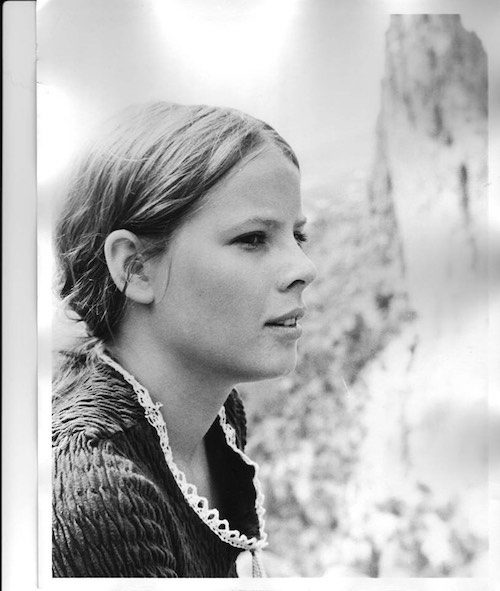
***
Late in August Walter Cronkite reported that thousands upon thousands of hippies had descended on a farm in upstate New York for a three-day music festival. The six o’clock news never showed any of the music, only the miles of traffic and abandoned cars and then finally half-naked people rolling about in the mud, Walter tut-tutting away like a maiden aunt. It looked amazing, the most fun a teenager could have. I watched desolate, knowing my tribe was out there, listening to the music I loved, taking the drugs I wanted. As always, life was happening somewhere else.
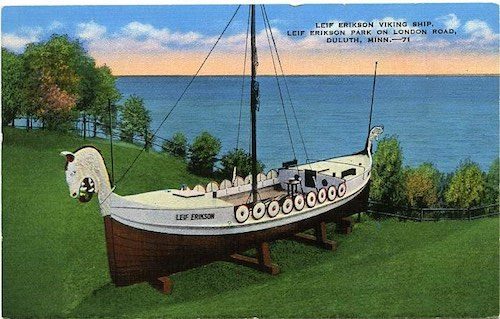
But Woodstock unlocked something in the teenagers of Duluth. As if summoned by the Pied Piper, throngs of kids coalesced in scraggy bands on the rolling green lawns of Leif Erickson Park, boys strumming guitars and girls twirling their long gypsy skirts around and around. At the downtown Woolworth’s next to the turtle tank I found a rack of buttons with peace symbols and “Make Love Not War” that I pinned on the lapel of my fringed jacket. The Age of Aquarius had reached Duluth.
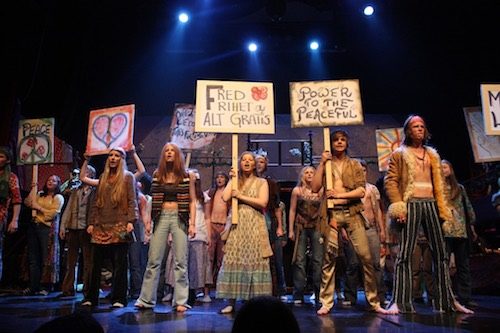
On the first day of school, I walked down the East High hall into a different world. A whole subset of druggies and hippies had sprung up like dandelions. There were dozens of kids in tie-dye, patchouli oil was used way too liberally, and almost every boy, including the jocks, had hair that brushed the collars of their shirts.
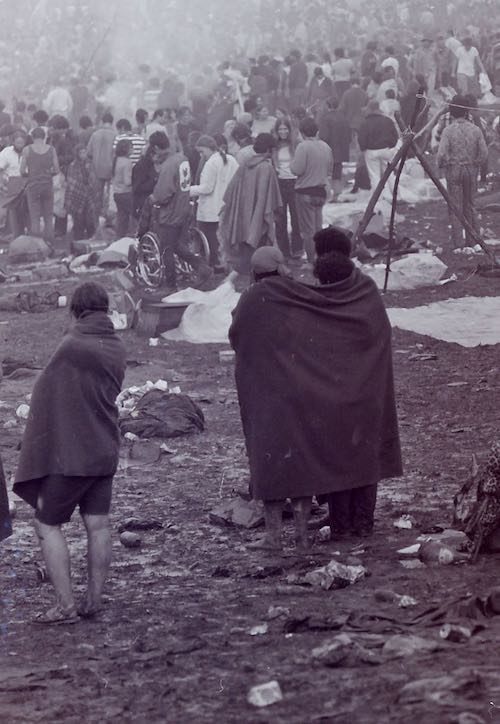

I made my way up to the third floor, to Mr. Burrows’ two-hour, buttock-killing, smart-kids-only, enthralling American History and Literature Class, an educational jewel that was more fascinating and more informative than any college course, even if it did hew to the Famous White Men model, with nods to Anne Bradstreet and Emily Dickenson. As I slipped into my usual seat next to Nancy Erman, she nudged me, nodded her head sideways, and daringly whispered “New boy. Your type.” Mr. Burrows’ thundering brow turned toward Nancy at this violation of his rule of absolute silence. She gave him a twinkling Nancy smile, and, mollified, Mr. Burrows went back to the chalkboard to write: “A true relation of such occurrences and accidents as hath hapned in Virginia. John Smith, 1608,” and we were off to the races, three hundred years of history and literature to cover in nine months.
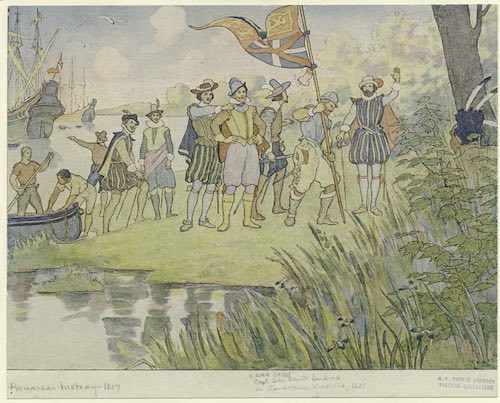
I snuck a glance in the direction Nancy had nodded in. Sitting all alone against the back wall, lit like a Renaissance angel under the slanting autumn light that poured in through the diamond-paned windows, was a boy with long dark hair that reached his shoulders and John Lennon wire-rimmed glasses. Beneath the glasses and the hair was a cherubic face, as round and sweet as an apple, a face that wore a serious, studious expression that reminded me to turn, reluctant and hopeful, back to my own interrupted note-taking on the founding of Jamestown.
This boy was Michael Vlasdic, my first love.
He was heart-meltingly handsome, and I knew that he had to be smart to be in Mr. Burrows’ advanced class. Two hours later, when Mr. Burrows allowed questions and comments, Michael sat silent, although I did see him occasionally smile, revealing adorable dimples that would be so much fun to kiss.
Michael Vlasdic was also in my lunch period, where I clocked him sitting at the back of the raucous East cafeteria with Roger Dennison, another rare new kid, who was good-looking in a blond, high-cheeked, Slavic way despite a nose like a jagged ski run, and with my old friend Eric Olson from elementary school. Eric was now known as Needle, not for his use of intravenous drugs but for his extreme skinniness. Roger and Needle both sported nicely shaggy hair, though not as long as Michael’s.
A year ago, I would not have been able to walk within ten feet of a boy I liked without my stomach flipping over and my tongue gluing itself to the roof of my mouth. But good luck and bad experiences had given me confidence. I had shed my virginity and my goofy glasses and I had Michael Vlasdic in my sights.
The new, sophisticated me plopped down uninvited among the three boys, making sure that I was next to Michael, and finally put my mother’s advice—“Just walk up to a boy, say hi and start talking”—to the test. I smiled, asked Roger where he was from (Colorado, his father worked for the Air Force and had been transferred to Duluth’s tiny base), talked to Needle, another smarty pants, about our classes, and finally turned to Michael and said “I like your glasses.”
I watched his face and my heart gave a small thump. I thought, I know this person, I have been this person, struck dumb at the prospect of talking to the opposite sex. It was as if I could read what was going through Michael’s mind: “What does that mean? Is she making fun of me? Or should I say thank you and then say I like your shirt?” I could tell he was weighing all his options as if one wrong word could open up the cafeteria floor and send him down to Hades, while the other kids laughed and pointed at him.
It was too painful. I jumped back in and carried the conversation single-handedly (look mom!) until the bell rang to send us off to class. That was also my signal to make my move. “So Michael,” I said, “What are you doing Saturday night?” All three boys exchanged shocked, mystified looks, but there was none of the horror that I used to see on the faces of the boy I asked to dance at Cotillion.
Michael quietly admitted that he had no plans for Saturday night and then looked as if he were waiting for a stinging, “Oh I’m going to a fun party” from me.
I took a breath and said, “Do you want to go out, go do something?” A beatific smile crossed Michael’s face, revealing those adorable dimples that I could have kissed right there and then. I took this as a yes. We scribbled phone numbers in each others’ notebooks and I left feeling that little squeeze of my heart and tingling between my legs that I got listening to Robert Plant moan “The Lemon Song” or re-reading the dog-eared pages in my copies of Lolita and Candy that I hid between the mattresses.
The Most Famous American Princess
Americans love a good fairy tale, especially if the princess is one of our own. With the news of Prince Harry’s engagement to American actress Meghan Markle, the U.S. is looking forward to playing a starring role in the royal wedding.
Markle has drawn comparisons to Grace Kelly, the American actress who married Prince Rainier III to become Princess of Monaco in 1956. Kelly was garnering acclaim in her own right as a model and film actress before joining the royal family of the 500-acre city-state. Pete Martin interviewed the rising star in 1954 for the Post’s article, “The Luckiest Girl in Hollywood.” At the time, Kelly was taking off in the film industry. She had struck a chord with Alfred Hitchcock after starring in Dial M for Murder and Rear Window, and months later she would earn an Academy Award for her role in Country Girl.
The next time Martin interviewed Kelly, in 1959, she was Princess Grace of Monaco, and no longer an actress. Kelly’s last role before her transformation into Monegasque royalty was in High Society with Bing Crosby and Frank Sinatra. Although she was no longer adorning the silver screen, the public celebrated Princess Grace for her perfectly apt role in nobility.
Like Grace Kelly, Meghan Markle will also be making the transition from actress to royal, and many Americans are excited to have one of their very own as a (possible) Duchess across the pond. If any group experiences the scrutinizing limelight more harshly than movie and television stars, it might be the British royal family. As much as Americans adore the prospects of charming weddings and cute Corgis, royal drama is just as relished. For the time-being, the only foreseeable controversy is Markle’s inevitable retirement from acting, which will inspire distress in her newfound fans.
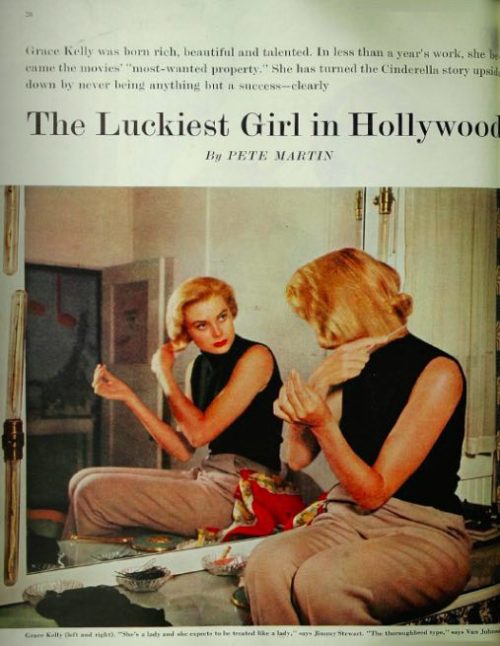
Celebrate a Norman Rockwell Christmas
To help you get into the Christmas spirit, we’re sharing some of our favorite vintage Christmas illustrations from The Saturday Evening Post. These funny, heartwarming paintings by Norman Rockwell, J.C. Leyendecker, and other artists will fill you with Christmas cheer in no time.
Your Weekly Checkup: Can You Be Fit and Fat?
We are pleased to bring you “Your Weekly Checkup,” a regular online column by Dr. Douglas Zipes, an internationally acclaimed cardiologist, professor, author, inventor, and authority on pacing and electrophysiology. Dr. Zipes is also a contributor to The Saturday Evening Post print magazine. Subscribe to receive thoughtful articles, new fiction, health and wellness advice, and gems from our archive.
Like many Americans, I am overweight—not a lot, but I’d love to lose ten pounds from my pot belly. Despite exercising an hour each morning, my weight remains constant because to lose, I must combine diet with exercise, and I don’t do the former. Because I lift weights and work out on the treadmill, bike, and elliptical, I tell myself I am fat but fit.
Is that really true? Can I be overweight and not at increased risk for heart disease? A recently published study based on the electronic health records of 3.5 million British patients followed from 1995 to 2015 says no. Being overweight makes me 30% more likely to develop coronary heart disease (atherosclerosis) compared with normal weight individuals, despite the absence of other health issues. The study outcome challenges the belief that I can be metabolically healthy (no diabetes, elevated cholesterol, or high blood pressure), overweight, and not at increased risk, possibly because obesity is associated with inflammation, and the latter plays a role in the development of coronary heart disease. They conclude that there is no such thing as benign obesity. Importantly, the authors also found that normal weight individuals who had metabolic risk factors such as diabetes were also at increased risk for developing coronary heart disease, despite not being overweight.
Critics argue that the study, despite its size, has flaws and that fitness outweighs fatness, if the latter is not excessive. This is a crucial point because many people, like me, find it easier to exercise daily than to diet. A bad combination is to be sedentary and overweight. Being fit at least counteracts some of the risk of being fat.
The same study found that being too lean also has risks. Underweight individuals with no metabolic abnormalities were at higher risk for stroke than individuals who were at normal weight, overweight, or obese with no metabolic problems. The risk to underweight people with metabolic issues increases even further. Metabolic health is important regardless of weight.
So, what should you do? Lose weight, of course. If you cannot, be sure to treat metabolic abnormalities such as controlling blood pressure, reducing cholesterol, and keeping blood sugar normal. This will counter some of the risk from being overweight. And get off the couch! Run, walk, exercise any way you want. But do something!
Top Tech Gifts for 2017
These cool tools will delight even your nerdiest family members.
Smartphones

The new iPhone X is one of the hottest — and priciest — gift ideas. So what’s new? Wireless charging, a prettier screen, and facial recognition software that takes a quick peek at your face to unlock the phone. The bad news: Prices start at $1,000. The more conventional iPhone 8 and 8 Plus start at $700 and $800, respectively.
For Android fans, Samsung has an impressive trio of high-end Galaxy models. The Note8 ($930 and up) has a gargantuan 6.3-inch screen; multiple biometric security options, including facial recognition, an iris scanner, and a fingerprint scanner; and a stylus for drawing and jotting down notes. The S8 and S8+ (starting at $725 and $825) have similar features with slightly smaller displays (5.8 and 6.2 inches, respectively) but no stylus.
Looking to save a few bucks? The OnePlus 5 is drawing high praise from tech reviewers for its great camera, long battery life, and relatively low price ($479 and up).
Tablets and Laptops

Amazon’s Fire HD 8 may be the best tech bargain around. Starting at just $80 for the 16GB model, this slim tablet has a bright 8-inch screen that’s great for reading, gaming, and streaming video. It runs for 12 hours between charges, and includes a microSD memory card slot for adding up to 256GB of stuff — books, music, movies, whatever. The built-in Alexa voice-controlled assistant is handy for to-do lists (“Alexa, add eggs to my shopping list”), checking the weekend weather forecast, tracking Amazon orders, and more.
The Chromebook, which is a laptop that pretty much only surfs the web, is the bargain alternative to conventional Windows and Mac machines. It’s great for anyone who spends all day online and doesn’t run standard PC apps. It’s secure, easy to use, and relatively cheap. The rugged Acer Chromebook 11 C771 ($280 and up) has a spill-resistant keyboard and can survive a 4-foot drop, making it a good choice for students. Its 32GB of storage can be expanded via a microSD card slot, and its battery life is a solid 12 hours. The touchscreen edition (C771T) starts at $330.
Streaming and Gaming

A media streamer — a gizmo for watching internet video services like Netflix, Hulu, and Amazon Prime on a TV — makes a great tech gift for someone late to the streaming craze. Best buys include the Roku Streaming Stick and Amazon Fire TV Stick; each costs $40 and plugs inconspicuously into a TV’s HDMI port.

For the hardcore Xbox gamer who wants the latest and greatest, the Xbox One X delivers the goods. Microsoft’s high-end game console features dazzling resolution and an immersive experience that really shines on a gargantuan 4K TV. The $500 price tag is steep, so be sure to check out the $250 Xbox One S, which has less powerful graphics and delivers simulated 4K through a technique called upscaling.

Fans of old-school gaming — think Super Mario Bros. and Street Fighter – may prefer the Super NES Classic Edition, a miniaturized version of Nintendo’s classic ’90s home console. The bundle includes 20 classic games and two wired controllers to complete the retro experience. Even better, it’s only $80.
Virtual reality (VR) headsets are fun for immersive gaming, but some cost hundreds of dollars. Google Daydream View ($79) is the bargain alternative. Insert a compatible Android phone (sorry, iPhone fans) in the View’s front pouch and experience VR worlds, including virtual tours of the great museums, from the comfort of your sofa.
The Grab Bag

The Amazon Echo Dot ($50) is a handy voice-controlled appliance and the least expensive member of the Alexa family. In addition to playing music and reading news and audio books, it works with smart home devices for controlling lights, fans, garage doors, and more.
A subscription to Audible, an online audiobook store, is inexpensive and easy to give (no wrapping!). A three-month membership is just $45, and your recipient will receive one credit per month to access more than 180,000 titles.

A luxury pen is elegant, refined, and pretty darn cool — until you lose it. The Cross Peerless TrackR ($250) features a tracking device that lets you keep tabs on your pen’s location. Using Bluetooth Low Energy (BLE) technology, the Cross scribbler has a built-in beacon that you can track via an Android or Apple (iOS) mobile device.
The Ultimate Ears Wonderboom ($100) is a petite Bluetooth speaker that delivers big sound outdoors. Its compact, round design makes it easy to carry around, and it runs for 10 hours on battery power. It’s water-resistant too — great for rooftop pool parties and water balloon fights.
This article is featured in the September/October 2017 issue of The Saturday Evening Post. Subscribe to the magazine for more art, inspiring stories, fiction, humor, and features from our archives.
Agatha Christie’s Two Unsolved Mysteries
The unexpected success of The Mousetrap is perhaps the one mystery in Agatha Christie’s works that she never solved.
When it opened in London on November 25, 1952, she told the play’s producer she expected it would run for just “eight months, perhaps,” before closing. Sixty-five years later, it is still being performed. Since 1974, it has continually appeared at London’s St. Martin’s Theatre, which make it the longest continuous run of any play. Ms. Christie was completely baffled by the play’s enduring appeal. In her autobiography, she wrote, “I had no feeling whatsoever that I had a great success on my hands, or anything remotely resembling that.”
It wasn’t the only unsolved mystery in her life.
In 1926, she left her husband and seven-year-old daughter and inexplicably disappeared without a trace. The story was recounted in The Saturday Evening Post in 1941.
Mystery Writer, Mystery Woman
All of the name is Agatha Mary Clarissa Miller Christie Mallowan. Somebody once said that she has made more money out of murder than any other woman since Lucrezia Borgia. She has done it by keeping all of her crimes on paper.
Although a large part of the English-speaking world has read one or more of Agatha Christie’s many mysteries at one time or another, very few people know much about her—and this is an age when the public usually knows all about its celebrities.
In fact, Mrs. Christie is something of a mystery woman. Even her agent and her publisher can supply little information about her.
Her manuscripts arrive without any of the explanations and interpretations in which most authors indulge, they’re published, they’re successful — some more than others. That’s about the net of it.
But (to point a paradox of the variety you’ll find in so many of her own murder mysteries) Mrs. Christie has in her time received an enormous amount of publicity. And (to pile paradox on paradox, again in murder-mystery fashion) the event which caused the spotlight of public attention to blaze upon her was itself a most baffling mystery— one in which she personally was the flesh-and-blood principal character.
This real mystery began on the wintry Surrey Downs of England where Mrs. Christie was living with her husband, Col. Archibald Christie, in 1926.
Shortly after dinner on a black December night she decided to motor alone across the Downs and do some thinking, something not unusual for a writer pondering plot complications.
Next morning Mrs. Christie’s abandoned car was found beside a hedge not far from a lonely stone quarry in the neighborhood. She had vanished without a trace.
The disappearance captured the imagination of the public in astonishing fashion, not only in England but throughout the world. Newspaper headlines from South Africa to Alaska front-paged the story day by day. Some of the news stories were on the cynical side, intimating that the disappearance was a publicity stunt because one of the Agatha Christie mysteries was running serially at the time.
One newspaper quoted Colonel Christie as saying that he thought his wife might have vanished during a sort of research experiment in her craft, because she often had expressed the belief that any inventive individual could disappear with complete success without much difficulty. A few friends supported this theory by relating how for years Mrs. Christie had been a very close student of the New York disappearance of Dorothy Arnold, reading everything published on the subject.
(Dorothy Arnold, the smartly dressed daughter of a wealthy family, left her parents’ home at 108 East Seventy-ninth Street, New York City, on December 12, 1910, after telling her mother she intended to do some shopping. She bought a box of candy at the Fifty-ninth Street store of Park and Tilford, and a copy of a book, Engaged Girl Sketches, at Brentano’s Fifth Avenue store. She’s never been traced from there to this day, despite thousands of false alarms down the years.)
The police took nothing for granted in the disappearance of Agatha Christie. In some swampland not far from her Surrey home was The Silent Pool, a bit of dark water covered by bracken and dead grass. It had been the scene of the death of one of the characters in a recent Christie mystery. Detectives dragged it again and again, thinking they might find the author’s body.
The theory that Mrs. Christie, a famous mystery writer, had disappeared to prove it could be done, intrigued the public. As the story grew into a seven-day wonder, search parties were organized throughout the British Isles, and hundreds of amateur detectives took up the quest. Society people joined in, in treasure-hunt fashion. Thousands of pounds were spent on the various hunts undertaken.
Eleven days after her disappearance, Mrs. Christie was traced to a Harrogate hotel through a note she had written. She’d been living there the entire time under the name of Nancy Neele, a woman she and her husband knew. She’d told stories of coming from South Africa, she appeared to have a great deal of money for shopping and entertaining, and the other residents of the hotel had considered her a gay and attractive recruit to their social circle.
At this point the newspapers began emphasizing their publicity-stunt suspicions with new vigor. Colonel Christie, a World War hero, seemed outraged. He retained two noted alienists, who examined Mrs. Christie and staked their professional reputations on the diagnosis that she had suffered a genuine loss of memory.
A little over a year later Mrs. Christie divorced her husband under English law. Subsequently he married the woman whose name Mrs. Christie had used at the Harrogate hotel. On a visit to Scotland still later, Mrs. Christie met Max Edgar Lucien Mallowan, the British archaeologist especially noted for excavating Ur of the Chaldees. They were married in 1930 and thereafter Mrs. Mallowan accompanied her husband on expeditions to the Near East, his special field. The trips served to supply background for her writing.
Although she was born abroad, Mrs. Christie’s father was a New Yorker, the late Frederick Miller. As a girl she was shy, unable to make conversation at parties, and more interested in reading than anything else. Poetry and serious novels in which most of the characters died constituted her first attempts at writing. For a time the press described her as “an American novelist.” She tried a detective story, for fun, and it clicked immediately with the British reading public.
Today Mrs. Christie is doing war work for England, as is her husband. Information about the details of what they are doing is not available.
What the Post account doesn’t mention is that Colonel Christie was having an affair with the real Nancy Neele, and had indicated he wished to obtain a divorce.
Agatha Christie had a long relationship with The Saturday Evening Post. In 1933, we serialized her Murder in the Calais Coach, which introduced Post readers to her fictional master detective Hercules Poirot. Her Post debut was followed over the next thirty years by nine more novels and three short stories.
Christie’s never explained her disappearance. It has been variously explained as a psychogenic trance or a bout of amnesia. Or perhaps she was tired of her husband’s philandering ways and decided to take a break. In a departure from her regular form, the mystery remains unsolved.
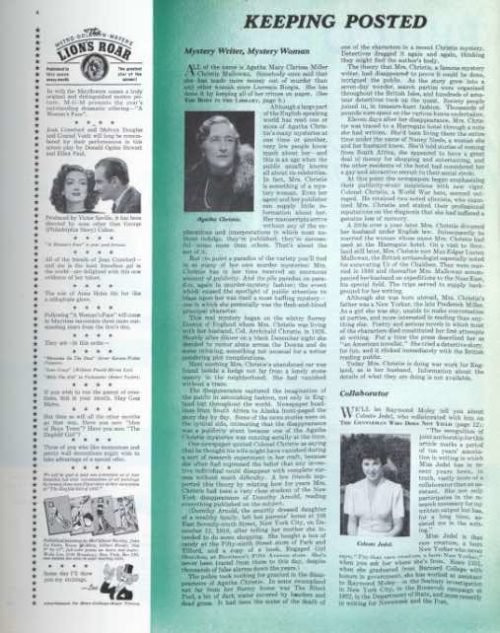
News of the Week: Black Friday, White Christmas, and the Many Joys of the Moist Maker
At Some Stores, It Actually Started Last Night
I don’t believe in Black Friday. I mean, I believe it exists. I’m not crazy, and I’ve seen all of the “pre-Black Friday sale” commercials. I just don’t think anyone should participate. Why stand in line with 1,000 other people just to save 40 percent on a toaster? You can always wait to buy the items (or buy them earlier than today), and there’s this thing called the internet where you can get all of the things you’re going to buy today (like, ahem, a new subscription to the Post), often at the same discount or even more.
If you do feel like shopping today, here are some tips for getting the best deals with the least amount of hassle. And don’t forget that this Monday is Cyber Monday, the day when many sites have big deals. By the way, when did the word cyber come back in vogue? I thought that went out with information superhighway.
If you’re feeling like a rebel, please note that today is also Buy Nothing Day. But I’d bet few people are going to celebrate it.
Christmas TV
Christmas season has begun, which means that Christmas TV season has also begun.
This amazing site has a really great list of all the Christmas specials and holiday movies that are coming up from now until New Year’s Day. So if you’re into movies like White Christmas and It’s a Wonderful Life or animated specials like Rudolph, the Red-Nosed Reindeer and A Charlie Brown Christmas, you’ll find it on the list. It even lists Christmas-themed episodes of TV shows, everything from ER and Friends to Father Knows Best and The Equalizer. You can even find out where you can watch classic Christmas specials from Bing Crosby, Perry Como, and Judy Garland.
I’ve looked at the schedule, and I’ve also done a search on some TV listing sites, and I don’t see Miracle on 34th Street at all. Seriously? I guess that’s why God invented DVDs.
Superman for Sale
I wasn’t a big comic book collector when I was a kid. I had some — I was into Superman, Batman, and Spider-Man — but I never thought about them enough to actually “collect” them. I had some in my attic, and once in a while I wonder if I ever owned anything that would go for a lot of money today. I never had the one where Superman made his first appearance though. I’d remember that.
That’s Action Comics #1, and it’s a rare, expensive thing, especially if it’s in fine to mint condition. One of them is going up for auction at Profiles in History in Los Angeles. It sold for 10 cents in 1938 and it could go for up to $1.2 million. It would make a great Christmas gift for the superhero fan in your family.
Maybe I should go back to my old house and check the attic. I’m sure the current occupants won’t mind.
Your NPR Name
There’s another meme (pronounced “meem”) going around the web — one of those things that passes from one person to another that everyone contributes to. This one is your National Public Radio name. Here’s how you do it: it’s a name that was popular in the 1880s–90s plus something that is being made obsolete by either global warming or the internet.
Mine is Clarence Brick and Mortar Stores.
RIP David Cassidy, Malcolm Young, Della Reese, and Mel Tillis
Four stars of the music world died this week.
David Cassidy was the lead singer of the Partridge Family on the 70s sitcom of the same name. He had one of the great voices in pop history, on songs like “I Think I Love You,” “Echo Valley 2-6809,” “I’ll Meet You Halfway,” and “Point Me In The Direction of Albuquerque,” and the group of studio musicians that played on the songs were first-rate. Cassidy died Tuesday at the age of 67.
Malcolm Young was a guitarist and founding member of the rock group AC/DC, known for such songs as “Highway to Hell,” “You Shook Me All Night Long,” and “Back in Black.” He died Saturday at the age of 64.
Della Reese started as a singer in churches and later with Nat King Cole, Ella Fitzgerald, Miles Davis, and many others. She then became an actress and appeared in many movies and TV shows, including a starring role on Touched by an Angel. Reese died Sunday at the age of 86.
Mel Tillis was known for his stutter, which didn’t affect his singing of country songs like “Southern Rain” and “Good Woman Blues.” He was also a songwriter, penning songs for Kenny Rogers, George Strait, and many others. He died Sunday at the age of 85.
The Best and Worst of the Week
A new feature of Week in Review, where I pick two things that particularly stood out the past week, one good and one bad.
The Best: I have a confession to make. I haven’t watched 60 Minutes that much in the past several years. Not that it isn’t a great show — it’s still the best newsmagazine on television — but the main reason I tuned in, the main reason a lot of people tuned in, was for Andy Rooney’s essay at the end. The show isn’t the same without him. So imagine the happy surprise fans had when they tuned into last Sunday’s episode and saw Rooney at the end of the show again! They replayed his essay on Thanksgiving, and I really hope it’s just the first of many returns that Rooney will make to the show.
The Worst: This also involves Rooney. Charlie Rose had Jeff Fager, longtime producer of 60 Minutes, on his PBS show. He was on for the entire hour, plus 15 minutes of the next episode, and they talked about every single contributor to 60 Minutes over the past 50 years. They talked about Mike Wallace and Morley Safer and Lesley Stahl, even Anderson Cooper and Oprah Winfrey and David Martin. Guess who they didn’t mention at all, not even in a quick, passing reference?
Andy Rooney.
Can you believe that? I was stunned. It was like watching a documentary on the Boston Red Sox and they mention all the players except Ted Williams. Rooney was arguably the most beloved person on the show for many decades, and he doesn’t get a mention? Very odd.
To make up for it, here’s an interview we did with Rooney in 1984.
This Week in History
First Appearance of Tweety Bird (November 21, 1942)
No, not that tweety bird, I’m talking about the little yellow bird from Warner Brothers cartoons. He (and yes, it is a he) made his first appearance in 1942’s “A Tale of Two Kitties.”
President Kennedy Assassinated (November 22, 1963)
This week, more of the previously unreleased files on the assassination were made public by the National Archives. The director of our own archive, Jeff Nilsson, has a nice retrospective on the many articles we’ve had on Kennedy over the years.
This Week in Saturday Evening Post History: Eavesdropping on Sis (November 19, 1949)
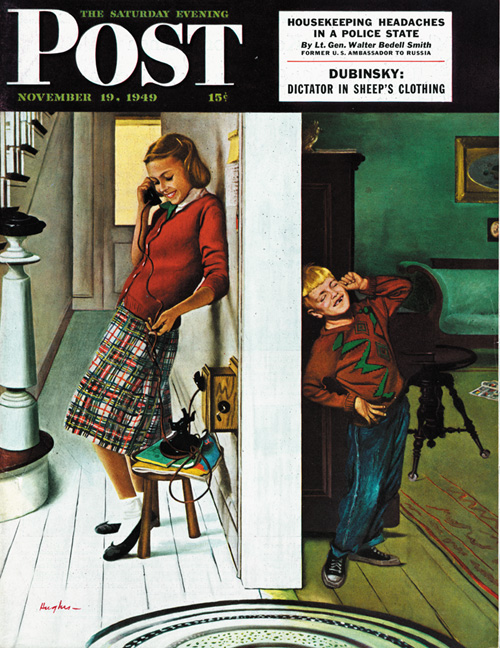
Eavesdropping on Sis
November 19, 1949
This scene by George Hughes is probably alien to many young people. Just one phone in the house, and it’s attached to the wall by a wire? That’s barbaric! But older people remember. I recall fondly the big, heavy black rotary phone we had in the corner of the kitchen. If you wanted to talk to your friends (or that girl you liked from school) on the phone, you had to do it there, in a high-traffic area. Now kids have their own phones and parents don’t know what’s going on.
This cover is actually one of three “eavesdropping” covers that Hughes did for the Post.
What to Do with Thanksgiving Leftovers

You probably have turkey and other foods in your fridge right now. My leftovers plan is pretty simple: I make sandwiches. I don’t make turkey soup or turkey casserole; I just heat up the turkey and stuffing and make big sandwiches. Also: reheated mashed potatoes taste funny to me.
Beyond sandwiches, here’s a recipe for Turkey Pumpkin Chili you might want to try. You get the two big tastes of the season in one bowl. Here’s a Next Day Turkey Primavera, and for something a little different, maybe these Thanksgiving Nachos.
Okay, if you’re just making sandwiches, let’s once again take a cue from one of the shows on that Christmas TV Schedule site: Friends. It’s The Moist Maker, the turkey sandwich Monica made for her brother, Ross, who flipped out when someone at work ate it.
The secret is the third piece of gravy-soaked bread in the middle.
Next Week’s Holidays and Events
Christmas in Rockefeller Center (November 29)
Last week I told you about the tree being delivered, and now you can see the official lighting and listen to the sounds of Gwen Stefani, Brett Eldredge, Leslie Odom Jr., Jennifer Nettles, The Tenors, and Pentatonix. The shows airs on NBC at 8 p.m. Eastern and is hosted by Matt Lauer, Savannah Guthrie, Hoda Kotb, and Al Roker.
Write a Friend Month Begins (December 1)
Personally, I think we should celebrate Write a Friend Month every month of the year. Here’s what you do: Get out some nice stationery — or go out and buy some if you don’t have any already — grab a pen, and take the time to write an actual letter. Not a quick note, but a real, long letter, the kind people used to write P.T. (pre-texting). Don’t use any smiley faces or web abbreviations like LOL. Put it in an envelope, seal it, place a stamp in the corner, and take it to a mailbox.
Oh, and don’t email or text the person to tell them that you’re mailing it to them. Let it be a surprise.
Cover Collection: Yuletide Shopping Shenanigans
The commercialization of Christmas is not a modern phenomenon. Holiday shopping can be a joy, but it often veers toward comedy. In the hands of Post cover artists, the mundane experience of making lists, checking them twice, and finally scavenging neighborhood stores to gather up holiday bounty is presented as equal parts delight, misery, and just plain silliness.
Under the humorous guise of this painting’s subject matter, Norman Rockwell makes use of snow as white space to break the image of an overloaded grandfather into completely disjointed components. It’s not quite a human being we are looking at, but pieces of one—a subtle nod to cubism, perhaps?
Incidentally, “Pops” Fredericks, the model for this illustration, was an actor who never quite succeeded on the stage or the screen, but who achieved immortality on Rockwell covers as a cello player, a seasick cruise passenger, a hobo, Ben Franklin, Santa Claus, and a beloved doctor patiently examining a little girl’s doll.
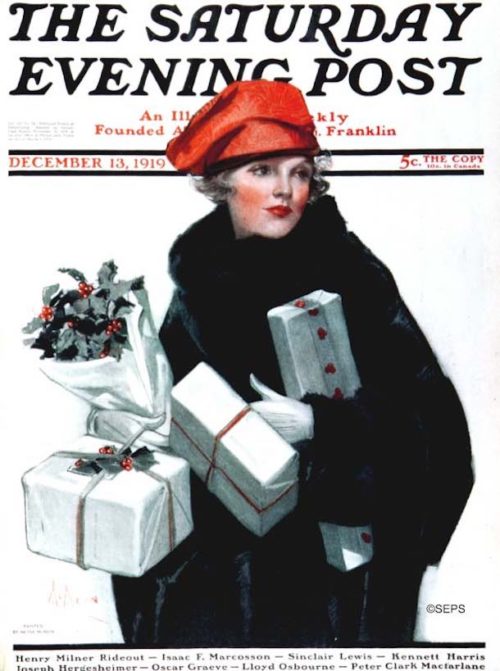
This stunning self-portrait by one of the Post’s more popular female artists makes use of winter’s white in an unexpected way. Not only is the background washed out—evoking a sense of snow—but the gifts are a stunning white against the stark black of the subject’s mink. The multi-talented McMein, a Midwestern girl from Quincy, Illinois, and star pupil of the Chicago Art Institute, moved to New York City with dreams of succeeding as an artist, poet, or musician. The year before painting this cover, she traveled to war-torn Europe as a correspondent for McClure’s Magazine. In the mid-1930s she would make an indelible stamp on the marketing world by creating the face of Betty Crocker.
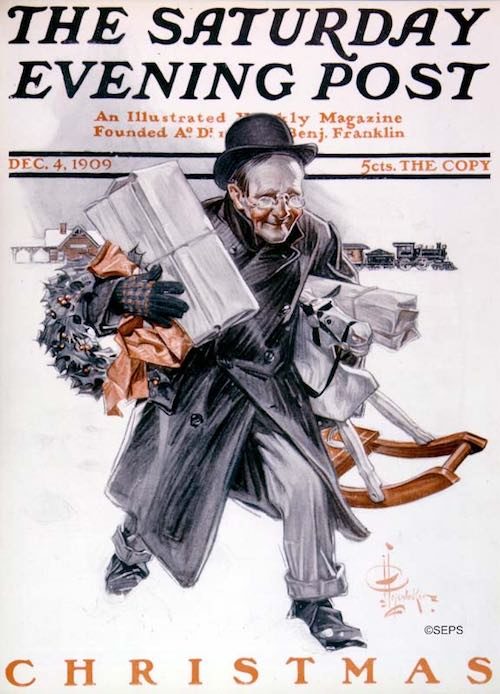
December 13, 1919,
Neysa McMein
The rocking horse was not new in 1909. It had been popularized in England during the 1800s, then galloped from small workshops into factory production. By the early 20th century, it was a staple toy in America and made frequent appearances on The Saturday Evening Post’s covers, especially around Christmas. Notice the detail in the harried commuter’s overcoat and pants. Leyendecker, whose roots were in fashion advertising, always gave close attention to the clothing of his models. A mentor to Rockwell, Leyendecker was also a darling of the public. At one point his fan mail eclipsed that of legendary film actor Rudolph Valentino.
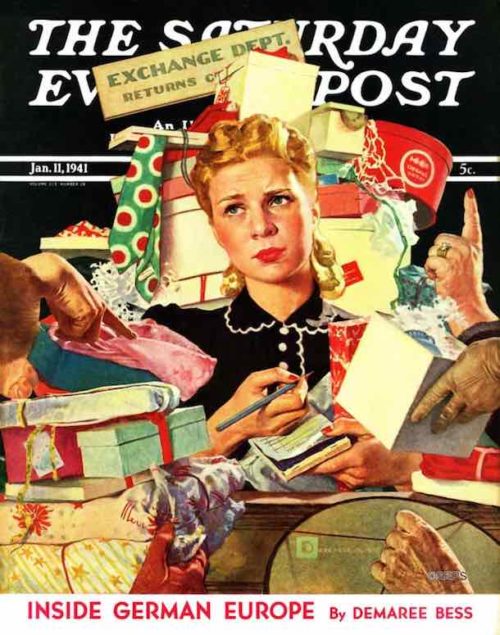
January 11, 1941,
Spencer Douglass Crockwell
The clerk’s face, almost floating in a sea of returned gifts, says all that needs to be said about the post-Christmas letdown. With its emphasis on the commonplace, the Post (and much of America) was willfully ignoring the global crisis brewing across the oceans. (The attack on Pearl Harbor that galvanized our engagement in World War II was still 11 months away.) Notice the signature, bottom right. Crockwell, who illustrated 18 covers for the Post, took to signing his illustrations “Douglass,” “DC,” or simply “D” to avoid being confused with another Post cover artist with a very similar last name.
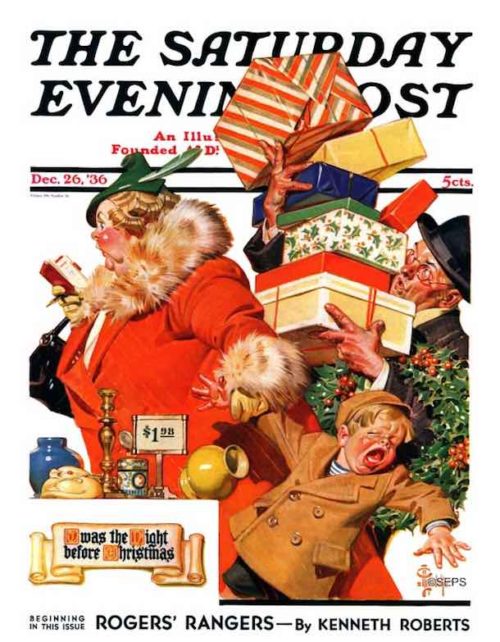
December 26, 1936, J.C. Leyendecker
Leyendecker was one of the longest running of the Post cover artists and certainly one of the most versatile. While best known for his stylish illustrations of fashionable people, he occasionally produced comic numbers, such as this colorful depiction of frantic, last-minute shopping. While many playful elements are at work, notice the visual pun of the bulky mom who bears an uncanny resemblance to St. Nick.
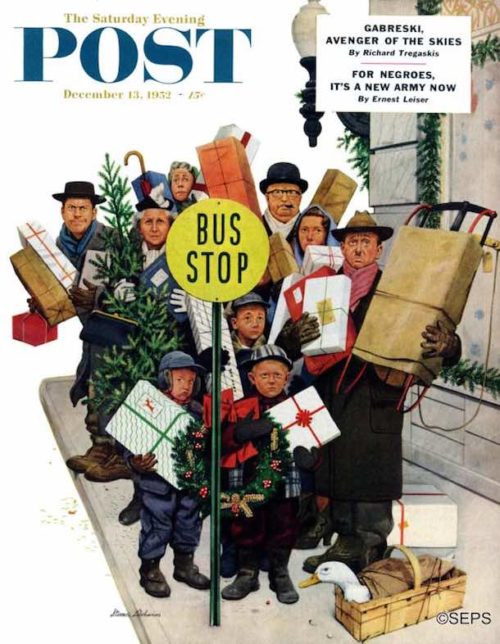
December 13, 1952, Stevan Dohanos
For this painting, Dohanos asked a man at a local nursery to
“saw me down a small Christmas tree to take out.” The little tree made this quirky cover in which all the players — duck included — seem remarkably complacent considering the circumstances. Post writer Rufus Jarman, a neighbor of Dohanos, makes a cameo appearance as the determined-looking man to the left of the tree.
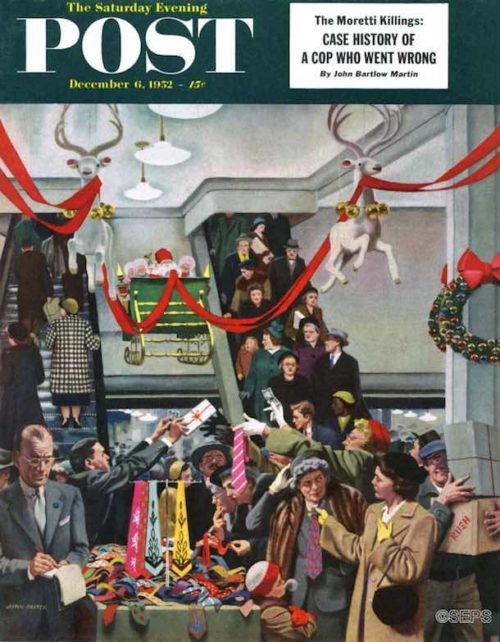
December 6, 1952, John Falter
Even 65 years ago, the ugly tie was universally recognized as the least desirable Christmas gift one could receive. But sometimes, well, that’s the best a person can do. For this hectic scene, Falter relied on his background working at his father’s clothing store in Falls City, Nebraska. By the late 1930s, Falter had moved to New York and was painting shirts and ties for Arrow Shirt ads before being discovered by the Post.
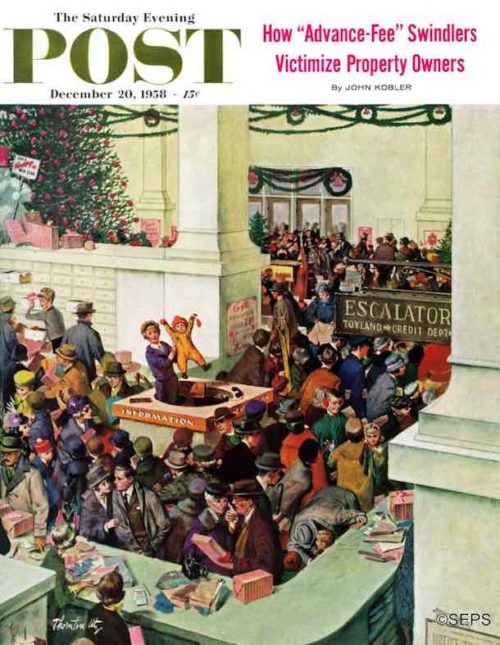
December 20, 1958, Thornton Utz
At the center of the image, a child at the Information booth will soon be reunited with misplaced parents. Meanwhile, countless other dramas are being played in Utz’s shopping pandemonium. Utz began drawing cartoons at 12 and knew he wanted to be an artist by the time he graduated from high school. But later he would say that he and a like-minded friend “could probably have been talked out of the whole idea if we’d been offered a good job driving a laundry truck.” With his knack for capturing humor in everyday situations, Utz became one of the most successful cover artists of the 1950s.
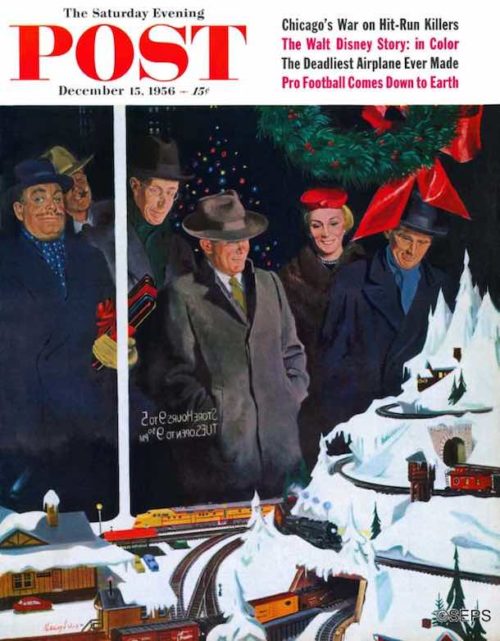
December 15, 1956, George Hughes
While drawing plans for a new home near Arlington, Vermont, Hughes decided to designate a room for his model trains. Months later, when breaking ground for his new home, his responsible side won out: He abandoned plans for the train room. But did he abandon his wish? One can almost feel the artist’s yearning for the magic of toy trains in this captivating holiday window display.
The Egg Man
It was Rose who found him. Rose, and not the bosses, since she’d come to work a bit early after dropping off her sister for a gallbladder operation. When she found Hughie in the stock room, he had yet to put on his white uniform. He was slumped against some boxes of Ketchup packages like a sack of potatoes. Rose was already in her purple cashier’s uniform, munching on a toasted English muffin. When she bit down hard on the last bit, Hughie could hear it crunch.
“You better not stay in here, bright eyes,” Rose said, in her singsong voice. Her hands were wrinkled and strong-looking, and seeing them always made Hughie feel a little spoiled somehow, as if he’d never had a job, never really worked ever.
“If you stay in here,” she went on, licking jam from a finger, “one of the bosses will find ya, and you’ll get the can.”
It was past six now, and Hughie ran through the number of things he had yet to get started: ovens turned on, batter mixed for French toast, coffee made.
“I’ll be ready,” he said weakly, fighting one of the worst hangovers of his life. “Just a few minutes, Rose.”
A wiry man who looked a little like Humphrey Bogart, Hughie had graying black hair and stern, tired-looking eyes. The black loafers he wore with his whites were the same ones he’d worn as a waiter a few months before; they were ruined now, mostly from cooking-oil spatter and the odd dropped watery tomato slice.
“No, you won’t,” Rose sighed. “You’ll try and crack an egg and end up mopping up your own puke. Then the bosses will come and you’ll get fired.”
“So you said,” Hughie murmured, his eyes closed.
“I guess you know,” Rose went on, wiping her hands now on a white cloth (she always managed to have a fresh one, even when the cooks were around), “that if you get canned from this place you’ll never work anywheres else. I guess you know that.”
Actually, Hughie hadn’t thought this through. Now though, opening his eyes and blinking, he began to consider that perhaps this wasn’t just another stint to see him through. He was 32 years old, a failed poet down on his luck, recently fired from a downtown bistro for swearing at a customer. The only job he was able to get after that was this one: putting out bacon-and-two in an airplane factory’s cafeteria on the city’s outskirts. When all else failed, he had always been able to work miracles with a couple of eggs, anyway you liked them. After his shift, Hughie would take the subway and streetcar to reach a room he had above a Vietnamese grocer on Bathurst Street. These days, most of his wages were spent at a bar where men old enough to be his father drank beer and watched hockey on an old tube TV. He was living like he was in his early 20s again, trying to maintain a devil-may-care image. Lately though, he had been weighed down by thoughts of going nowhere fast, not being able to write anything. Walking through Chinatown on a fall afternoon, for instance, with an Al Purdy paperback wedged in his back pocket, had lost its charm.
“Your French toast ain’t bad,” Rose offered.
“I’m going to get another job, Rose,” Hughie announced suddenly, trying to laugh. He was embarrassed by her standing there. He had come in at 5:30 hoping the headache would fade if he just stayed perfectly still in the dark with his eyes closed. It wasn’t working. He was clammy and sweating, his stomach still too queasy, even for the cafeteria’s weak coffee.
“No,” Rose sighed again, “you won’t get another goddamn job. The bosses will can ya, and you’ll never work anywheres. This ain’t the Royal York Hotel. It’s an old airplane factory. If you can’t put out the bacon here, you can’t put it out anyplace.”
In the large dining hall, which was a converted hangar, the windows reached the ceiling, as in an airport, offering a full view of a runway. Always there was the soft din of voices floating around, and in the mornings the early sun rays exposed columns of dust motes. Workers coming in during their breaks walked through these cloudy, yellowish beams, like specters in a silent film.
Exactly six years ago, a drunk drove a shuttle bus into hangar No. 4. Rose’s husband, Larry, along with two other mechanics, were killed. Everyone thought Rose would leave, but she stayed on afterward and kept her job on the cash register. Sometimes, when the breakfast shift was over and the sound of rattling plates and rushing tap water drifted out into the dining hall like a distant waterfall, Hughie would walk out with a coffee and notice Rose standing in front of those enormous windows by herself, staring out at the runway.
“I can’t believe you drink it black,” Rose, who always took it double-double, usually said when she noticed him.
She waded into the stock room now, lightly flicking her cloth against the boxes; a short, compact woman with round shoulders. Her shoes were so spotlessly white that Hughie couldn’t look at them.
“It’s nothing new,” she said, dusting. “You’re down, you’ve hit a rough patch. But remember, Hughie — I know. When my Larry was killed I was like you: coming in early and hiding in the stock room.”
“I just told you I’m going to quit,” Hughie said, hoping she would leave. “In exactly five minutes, I’m walking out of here and never coming back.” But as he sat up and pretended to be alert, he thought of the letter that had arrived for him at his room above the grocer. It was the only letter that had ever come for him since he’d been living there. Forget us, it had pleaded. Please forget us, for we are done with everything now and want to make a new life.
“You are, eh?” Rose said. “And where you gonna go? The North Pole?”
The letter was from Hughie’s wife.
She had taken the girls back to Vancouver, again, to live with her folks, hopping a plane on the credit card her father gave her for emergencies. As Hughie read the letter, he seemed to feel that he might not see them again for a long time. Karen had written without any references to the hopes and dreams that had been dashed long after they left university: his failure to get his poems published; and him acting like some imitation Dylan Thomas while they made it to the end of each month with checks from his father-in-law.
“Are you really trying to write?” Karen had said. “I mean, seriously.”
“I’m a bit blocked at the moment,” Hughie allowed. “It happens.”
Karen sighed: “I blame that what’s-her-name, that English prof who screwed up your head.”
“She said I was a big talent,” Hughie said.
“She also called you Humph and patted your bum.”
“She only did that once.”
“Did she mention we’d be struggling financially for the rest of our lives? My dad said he’d help us if we both go back to finish our degrees. We could teach college, Hughie.”
“You can if you want. Al Purdy slogged it out in a mattress factory and lived in a shack because he believed in himself. You have to be committed.”
“Committed to poverty, you mean. Look, I’m not trying to be mean, Hughie, but have you really got what it takes?”
“Purdy didn’t start out great.”
“But there must have been some signs, early on. It’s just not happening with you. Admit it.”
“So you don’t support me.”
“We have to think about the kids.”
“I had a brother-in-law like you,” Rose said, interrupting his thoughts. “He was a dreamer. Tramped around a bit before he settled down. Even went to Australia.”
Hughie rose up from the Ketchup boxes suddenly, indignant.
“Look,” he said, “not that it matters to you or anyone else in this dump, but I’m really a poet. I shouldn’t be here at all. I’m just in a bit of a rough patch, as you said. It doesn’t mean I’m going to spend the rest of my days making cheese omelets for a bunch of grease monkeys.”
Rose dismissed him with a wave of her cloth.
“It’s past six now,” she said hoarsely. “Hardly any time before the bosses see ya.”
She shut her mouth tightly and nodded at him intently, letting this sink in. Then she said: “When my Larry was in the accident, we had an old gal here doing the baking. And do you know what that old gal said to me?”
“Five minutes,” Hughie said, “and I’m gone.”
Rose said: “Lemme tell you what she said. She said, ‘Rose, you get out there and do the cash — it’ll blow.’ But I was like you, and I thought everyone who tried to help me was full of baloney. Then one morning I thought if that old gal can come in here at half-past five every morning for damn near 30 years and put them big oven mitts on, then what the hell have I got to complain about?”
She folded her cloth, her round face revealing a flicker of shyness.
Hughie had closed his eyes again. The voice in the letter was inside his head like a lonely prayer: Let us get on with our life. A new life.
“What are you writin’ anyway,” Rose said. “Your memoirs? Bring me down that big mustard box and come out here a minute. Hurry up, before the bosses come.”
Hughie blinked once, then reached for the shelf mechanically, for lugging boxes of mustard or vinegar from the stock room was something he did for her sometimes. This was supposedly because of her bad back, though Rose looked strong enough to put his thin frame over her shoulder. As they shuffled through the empty kitchen, Hughie heard the hum of the oven exhaust fans, as Rose had remembered to turn these on. The old gal that had given Rose a talking-to all those years ago was retired and gone. Everything came in from an outside bakery now.
“I like walking out here when she’s quiet, before anyone gets here,” Rose said as they entered the big dining hall.
Outside it was getting bright enough to see the hangars and the tarmac. Huge cereal-bowl lights overhead were still on, just like the ones in the old-fashioned streetcars he used to see downtown. In 20 minutes, the first shift of mechanics and maintenance crews would creep in for their toast. Rose had remembered to put the coffee on, too, and the aroma seemed to relieve Hughie’s throbbing head slightly. The mustard box was balanced on his thin hip.
“Set it here, Hughie,” Rose said. “Not on top of my cash, mind.”
Her workstation was in the center of the gaping hall. It was military green, about 10 by 6 feet, and at one end was the cash register. More than 500 people would file by before Rose’s shift was over, most of whom she knew by name. All the condiments — tiny white packages of relish, ketchup, and salt and pepper — were in shiny stainless-steel containers. Every afternoon at two before she went home for the day, Rose scrubbed these out with Mr. Clean.
“There — see how I’ve got it?” she said, prying open a box with a butter knife. “Everything all laid out, eh? And every morning I come in and make sure it’s nice for the whole day. My salt, my cutlery, my Sweet’N Low.” She indicated the pink packages almost with affection, as if the whole world depended on a shiny container of coffee sweetener topped to the brim.
“Almost done,” she said, shuffling around the station.
Hughie watched in silence. He glanced at the grill where he should have been by now, wondering, of course, if he really would quit this morning, and whether he would try to make it out to Vancouver to make yet another pitiful apology. He was also wondering what kind of person people had seen these last few months as they filed by for their breakfast. Last week a tired-looking security guard in his 60s brought his plate back to the counter and shook Hughie’s hand, saying it was the best bacon-and-tomato sandwich he’d ever had. Hughie had felt a bit embarrassed, but the compliment stayed with him.
“You do your eggs nice,” Rose called to him. “The guy before you kept the grill up too high. Maybe you can write a cookbook. Here’s a title for ya: The Egg Man.”
She came over to him wiping her hands.
“Now,” she said, “you’re gonna go back there and make sure I’ve got enough eggs so I don’t get short while I cover your shift. And while you’re doin’ that, I’m gonna get your bacon started. Then I’ll tell the bosses you got sick.”
Hughie kept looking at her as she quickly and expertly got both workstations ready at once.
“And then tomorra’ you’ll come in all bright-eyed,” she went on, “and this will never happen ever again. Now get out of here before anyone sees ya, the state you’re in. Christ almighty, ya look like a dog’s arse.”
She let out a cackle as she bent down to shove a box of mustard under the counter. When she stood up she blinked at him.
“What ya’ starin’ at?” she said.
“I was just wondering who’ll do your cash this morning,” Hughie said, “if you’re going to be the cook.”
Rose shrugged, giving him a sly wink.
“That’s for the bosses to worry about.” She started moving briskly over to the grill. “You gettin’ me them eggs, or aren’t ya?”
It was very late. The big cafeteria would soon be filled with the hubbub of workers clamoring for coffee and toasted Westerns. So Hughie went into the walk-in fridge to get six cardboard flats of large eggs. After he brought them out, he silently made his way to the exit, breaking through the columns of dust motes among the din of distant voices.
He could hear Rose, who was in front of the grill with a shiny metal spatula in her hand, talking to a customer.
“He ain’t here today,” she said in her singsong voice. “He’ll be back tomorra’.”
Cartoons: Black Friday Funnies
We’ve learned that if you’re about to throw yourself into the midst of holiday shopping chaos, you better have your sense of humor with you at all times. Here are some of our holiday cartoon favorites dating back to the 1920s.
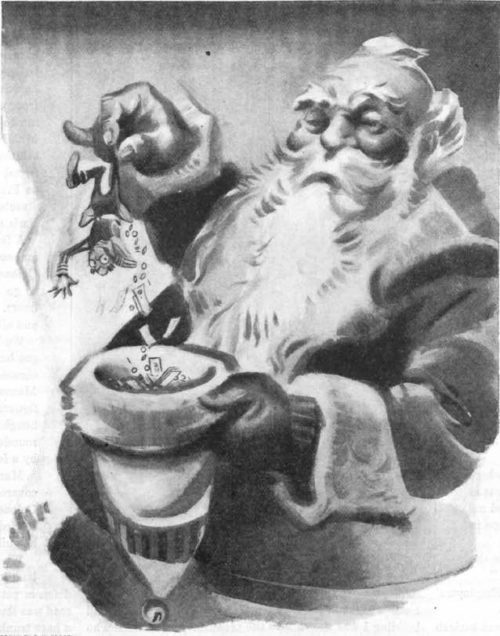
C.H. Forbell
December 16, 1922
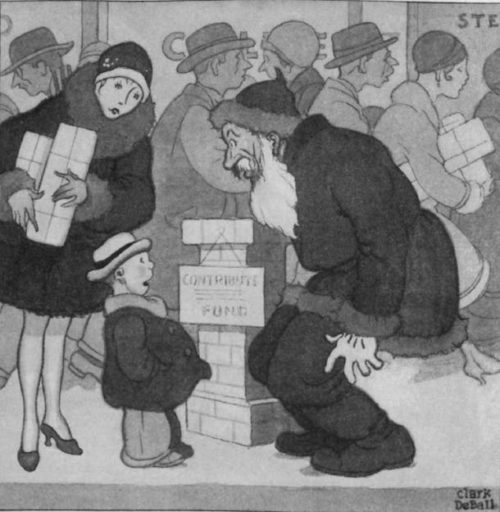
Bobbie: Naw, I Want a Thermocoupled Milliammeter and a Supersynchronous Rectifier for My Radio Transmitting Set
Clark DeBall
December 11, 1926
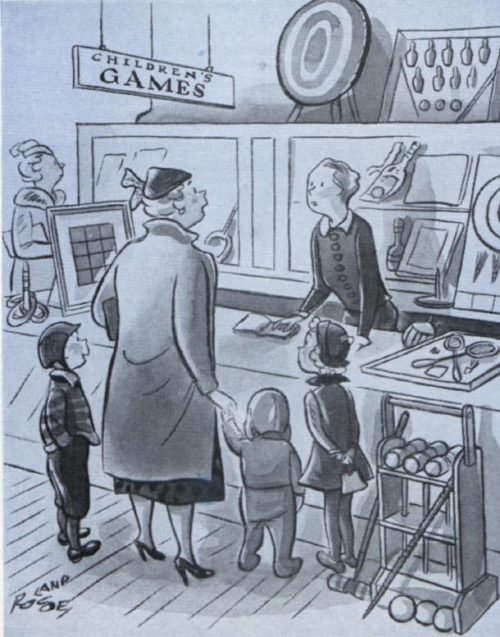
December 28, 1940
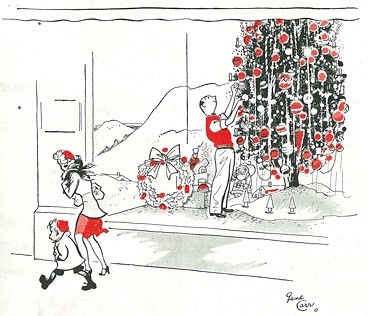
Jack Carr
December 1943
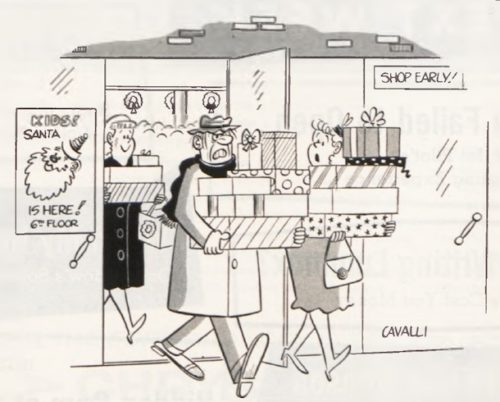
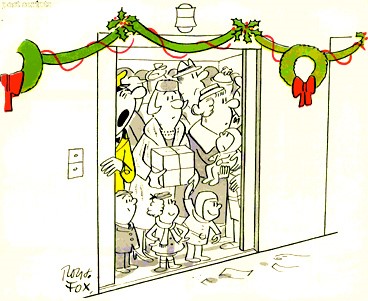
December 1961
Rondo Fox
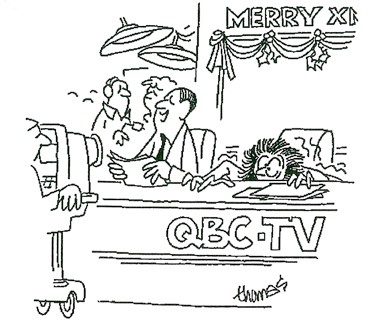
Thomas
December 1993
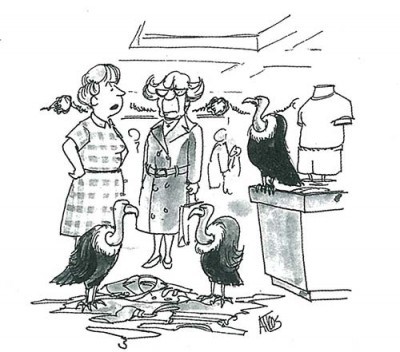
December 2003
An Adulting Odyssey with the Millennials
In the 1960s, the Post‘s humor series, “The Human Comedy,” focused on broad social issues and generational divides for its surreal and satirical slant. “An Antacid Trip with the Tweeny-Boppers” was Roger Price’s 1967 sendup of the hippie generation. This new installment imagines a millennium twist.
After some lessons in vocabulary, I felt confident in attempting communication with the Millennials. As a member of the Homeowning Generation, I educated myself in twentysomething slang by following every cast member of HBO’s Silicon Valley on Twitter.
Us Baby Boomers had our own hip lingo. We called money bread. The Millennials call it avocado. If we had a categorized interest or scene, it was our bag, and the younger generation calls this dietary restrictions. One of the most controversial new words is fleek. This is a caustic curse word you might have heard before, as in: “Tanner! The fleeking landlord is outside! Hide the fleeking dogs! Fleek!”
But one verb has continuously confounded me: adulting. Is it the opposite of kidding? A new parlor game? Some kind of Most-Dangerous-Game-style hunt of geriatrics?
I had to get to the bottom of this newly popular expression, so I went to a place that was sure to be crawling with Millennials: a tech startup.
The Naming Convention was bleeding-edge B2B crowdfunded lean startup, which, as far as I could tell, meant they kept a bottle of 20-year-old Scotch in the first aid kit. The Naming Convention recently launched an app to generate names for other tech startups, like Boostspace and Upkick. I arrived at their storefront around midnight since I was told the full-time freelance consultants there work nine to five (9 p.m. to 5 a.m.). Joey, the founder, greeted me at the door and let me in. The office was a combination of deteriorating brick walls and chrome with a seven-foot cactus in the center of the room.
Joey wore a houndstooth jacket over a plaid shirt, and he showed me around the space. A handful of employees were spread around the room sitting in swings fastened to the ceiling and working on touchscreen tablets. Now that I think of it, were they working?
“The swings are made of repurposed bamboo and sustainable hemp,” Joey said. One worker was pouring barley wine into a collectible Smurfs glass from a tap in the wall.
“Joey, it’s all very nice,” I said, “but I need to ask you something.”
“I know — you want to know about ‘adulting.’”
“Exactly.”
Just then, his electronic watch spoke out in a feminine voice about an appointment.
“Thank you Aurora,” he said.
“Who is Aurora?” I asked.
“My watch. Listen, we have a team-building cycling session right now — Aurora, remind me to check Daleyza in the morning.”
“Is Daleyza your phone?” I asked.
“No, that’s my daughter. I’m busy right now, but why don’t you join my partner and me for brunch tomorrow?” He strapped on a vintage bike helmet.
“What is brunch?”
“It’s like church with champagne.”
The next day I met Joey and his partner, Stephanie, at their favorite brunch restaurant, Poached Modern. They each ordered papaya-infused Bellinis with shots of mezcal, so I followed suit. After several more drinks, I wondered if brunch usually included eating.
“You’re both adults, right?” I asked.
“Well, sure,” Stephanie answered.
“Are you adulting right now? Is this adulting?”
“No, no, no, this isn’t adulting; this is brunch,” Joey said. “Adulting is, like, important tasks, things you have to do that you don’t want to do.”
“Military service?”
“Um, not really.” Joey looked around. “Aurora, can you explain adulting?”
Joey’s watch lit up: “Adulting, verb, achieving common responsibilities daily, such as banking, scheduling doctors’ appointments, and personal hygiene — ”
“And changing the oil in your hybrid car!” said Stephanie.
“And tying a tie,” chimed in Joey.
“Those are just normal, everyday undertakings! You have a name for things like that?” I screamed. They sat flustered, staring down at their Bellinis. “Well — I — I just mean maybe you don’t need to do that stuff at all. Why should the Man tell you what to do anyway?”
“You mean we don’t need to file our taxes?” said Joey.
“Or move out of my parents’ basement?” added Stephanie.
I started, “That’s probably — ”
“Thank you for joining us for brunch,” Joey interrupted, “but we’ve got to go now.”
“We’re going to Uber to the store to buy some really potent marijuana, then we’re going to watch old John Wayne movies ironically,” Stephanie said.
They walked out, leaving me to pay the bill. Damned Millennials. What can you expect from a crop of people still on their parents’ cell phone plans? A generation taught that each individual is a special star destined for their own incomparable fate? Why aren’t Millennials jaded like us?
The waiter delivered the check on a Spode tray with a little more attitude than was necessary. I wheezed. “Fleek! I don’t have that kind of avocado!”
Best Books for the Holiday Season
Every month, Amazon staffers sift through hundreds of new books searching for gems. Here’s what they chose especially for Post readers this holiday season, whether you’re looking for a thoughtful gift or just a good story to tuck into after the turkey’s gone.
Fiction
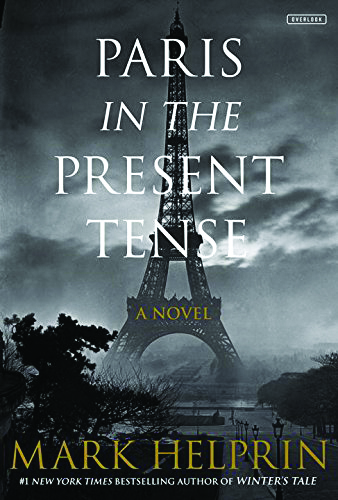
Paris in the Present Tense
by Mark Helprin
A 74-year-old artist and veteran lives between the beauty of the present and his past struggles.
Overlook Press
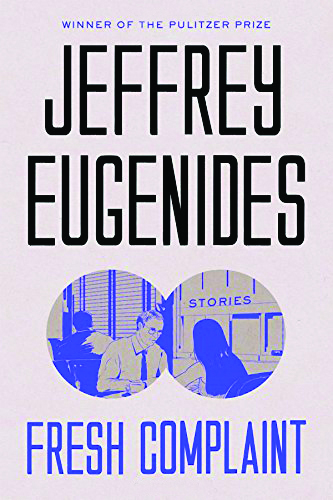
Fresh Complaint
Jeffrey Eugenides
This collection of short stories by one of our greatest authors is both brilliant and varied.
Farrar, Straus and Giroux
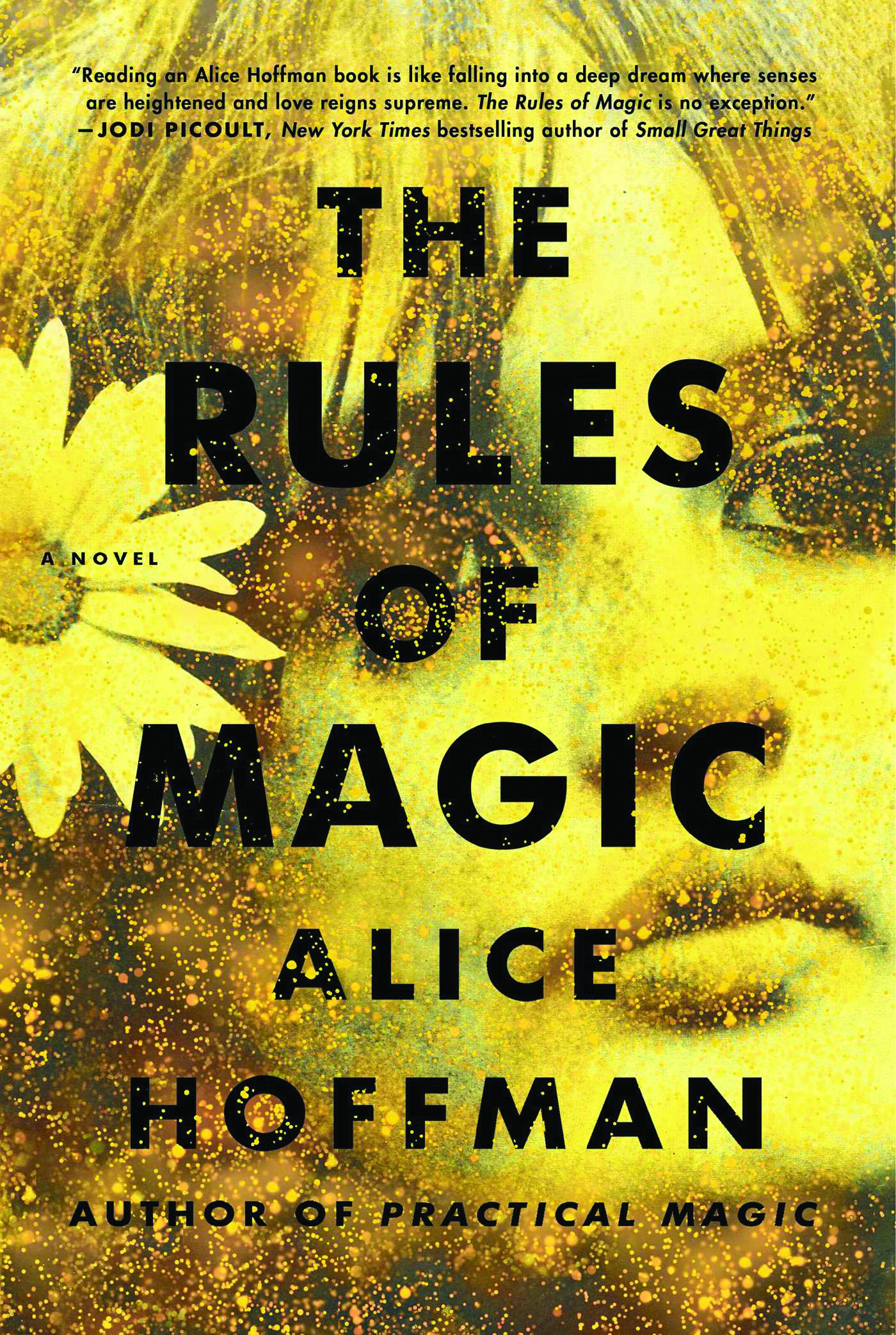
The Rules of Magic
by Alice Hoffman
The beloved author has written a prequel to her equally beloved Practical Magic.
Simon and Schuster
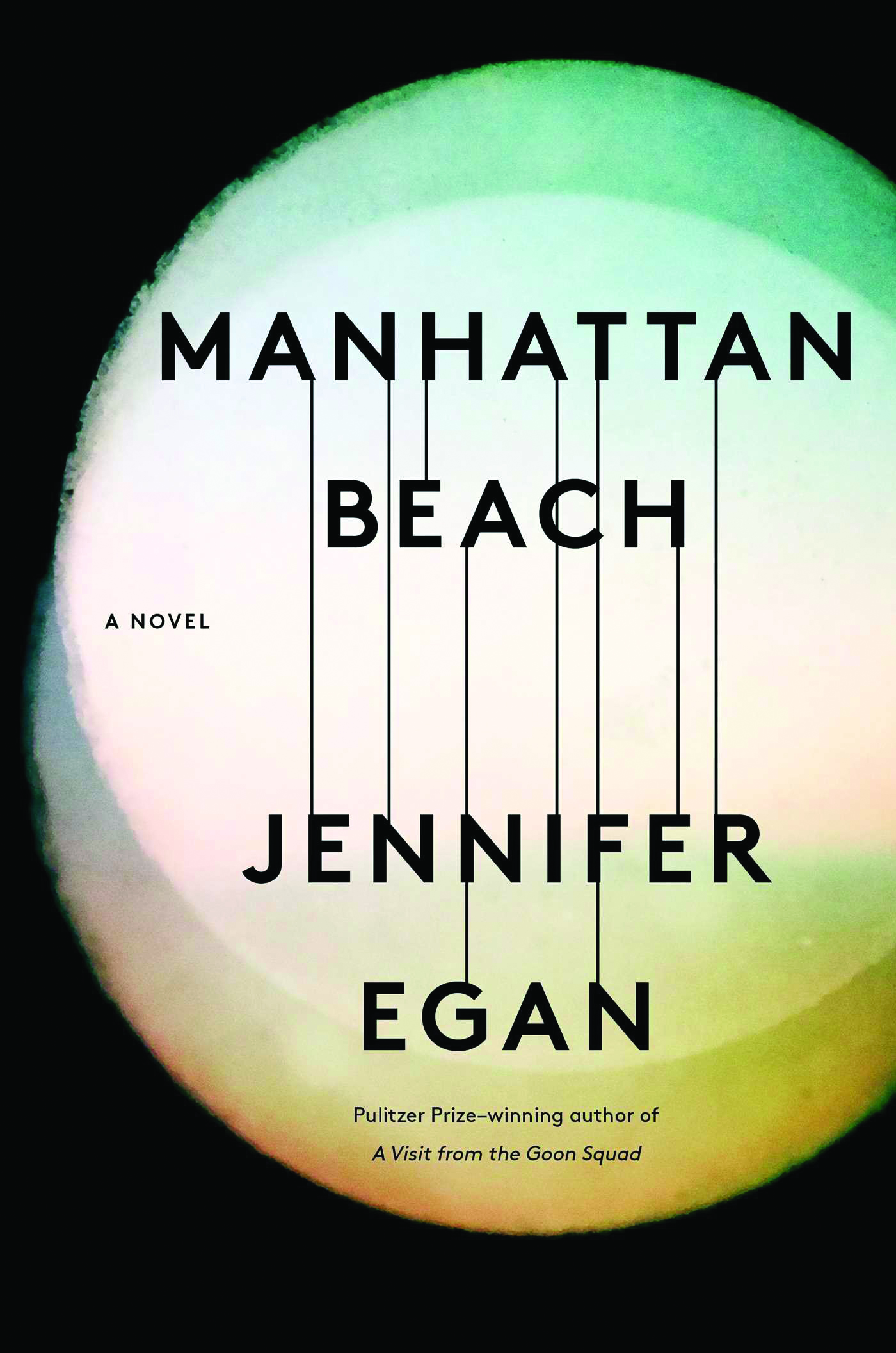
Manhattan Beach
by Jennifer Egan
During WWII, a woman becomes the first female diver at the Brooklyn Navy Yard, where she repairs ships.
Scribner
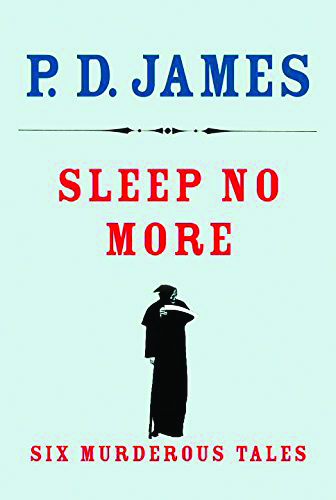
Sleep No More: Six Murderous Tales
by P.D. James
Here’s a collection of six short stories by the late, great master of the detective novel.
Knopf
Nonfiction
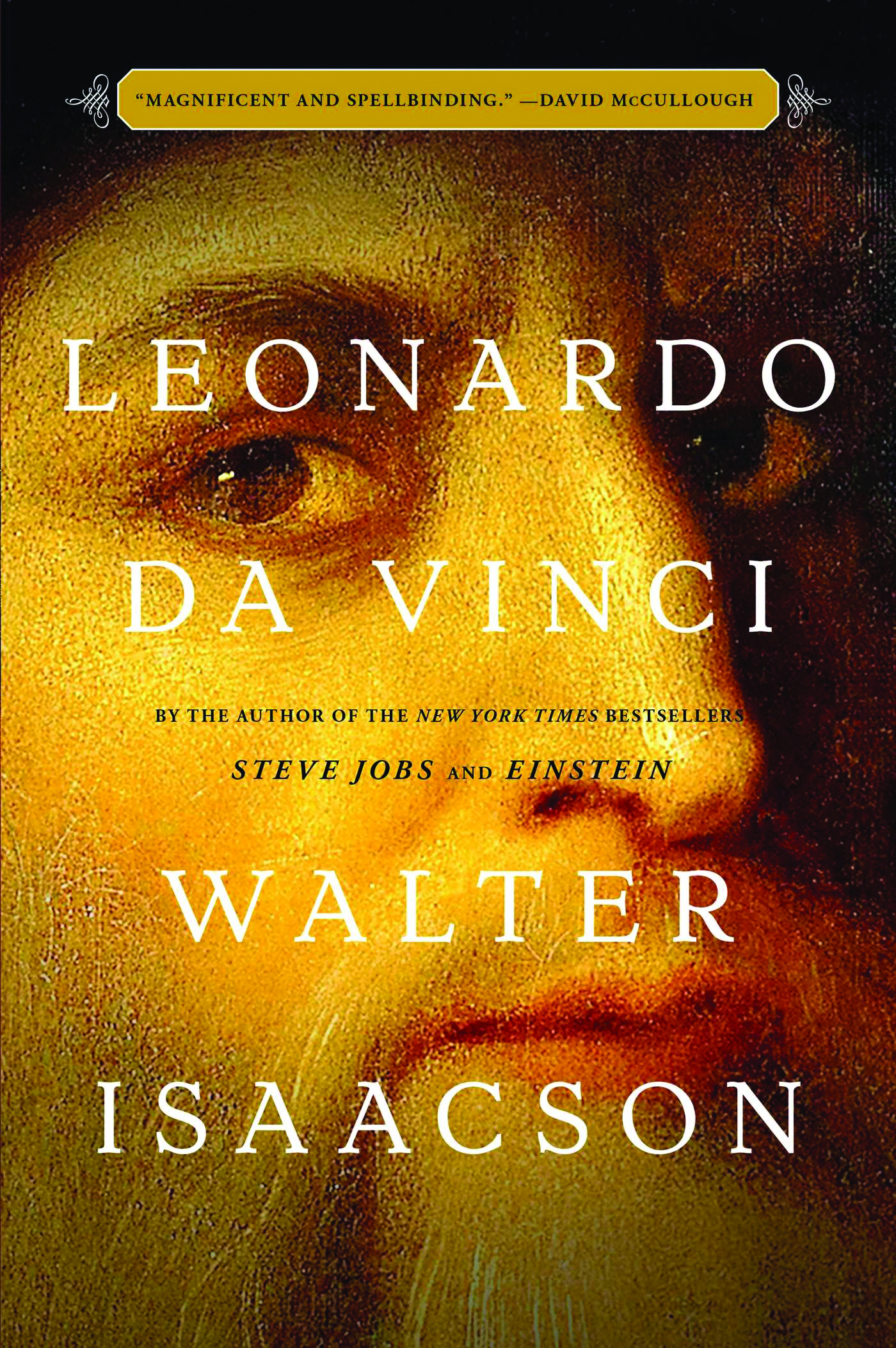
Leonardo da Vinci
by Walter Isaacson
The author paints a fascinating portrait from the Renaissance master’s notebooks.
Simon and Schuster
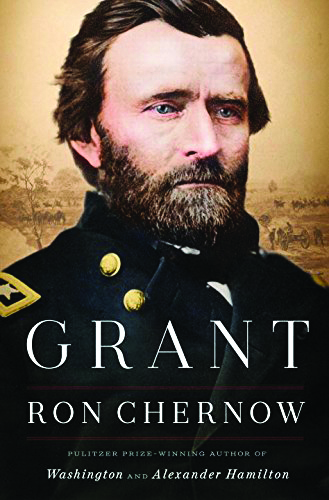
Grant
by Ron Chernow
Hamilton’s biographer has written a giant, gripping biography of one of the most misunderstood presidents in our history.
Penguin Press
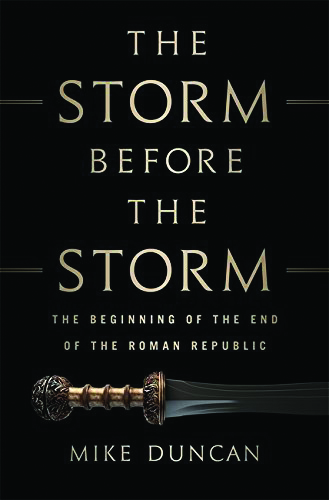
The Storm Before the Storm
by Mike Duncan
The creator of the wildly popular podcast The History of Rome sets the stage for the fall of the Republic.
PublicAffairs
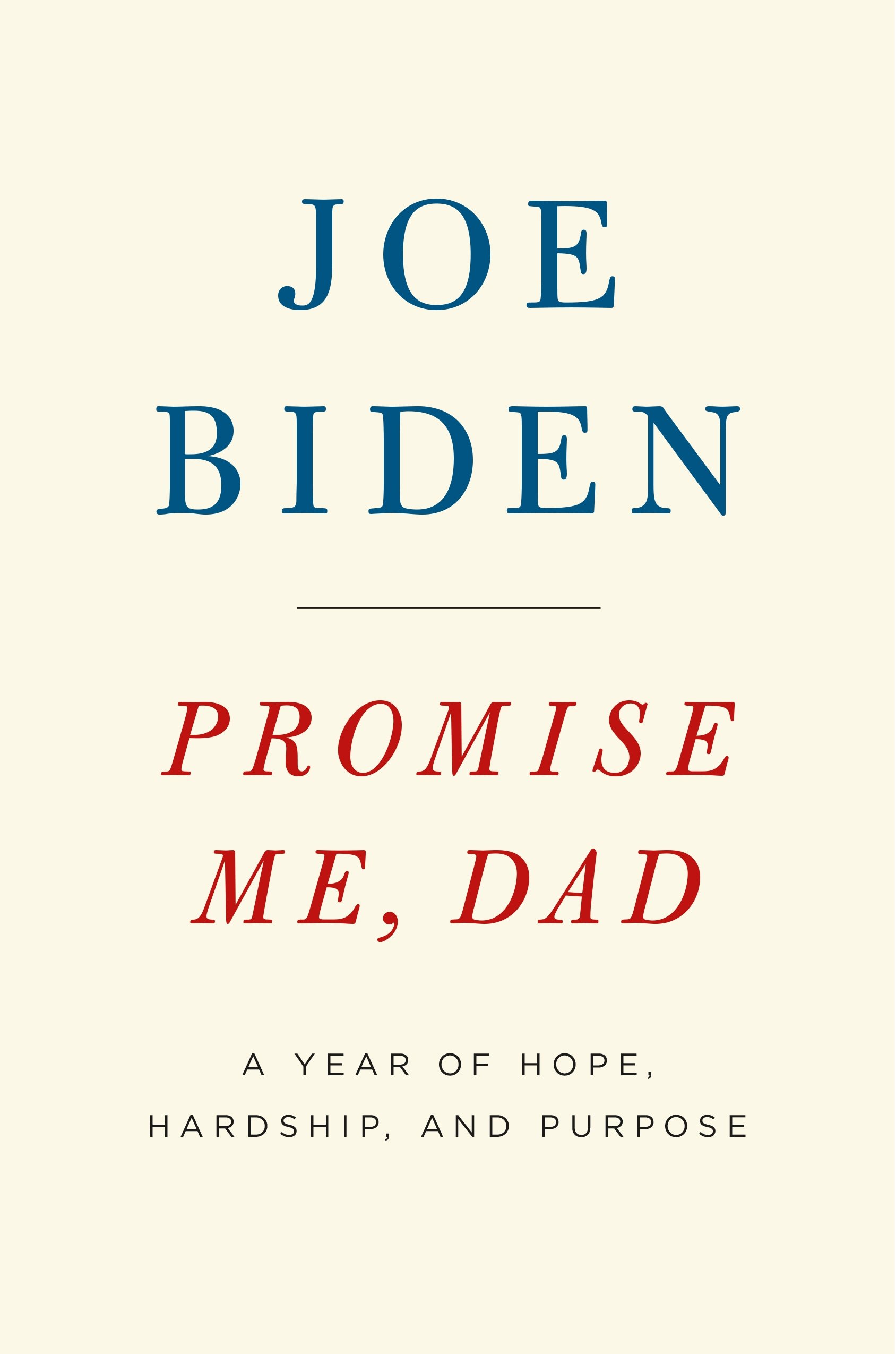
Promise Me, Dad
by Joe Biden
The former VP chronicles the year following the day his son Beau, diagnosed with malignant brain cancer, uttered those words.
Flatiron Books
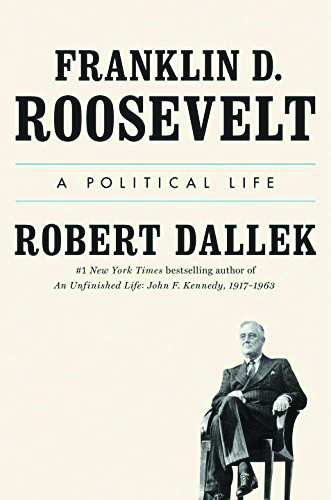
Franklin D. Roosevelt
by Robert Dallek
A one-volume biography of the incomparable politician and deal-maker.
Viking
Gifts
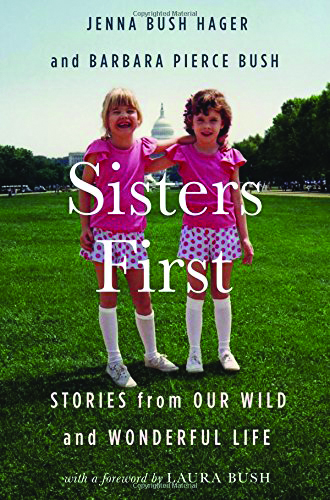
Sisters First
by Jenna Bush Hager and Barbara Pierce Bush
Former first daughters share family stories of adventure and sisterly bonds.
Grand Central Publishing
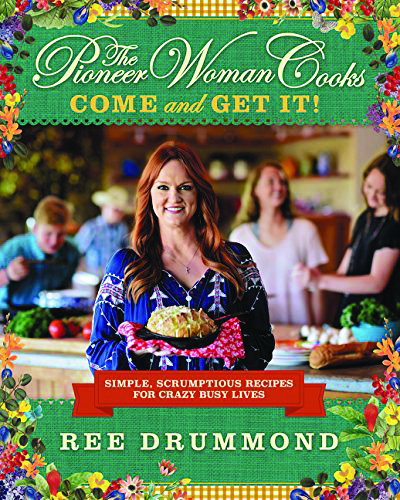
The Pioneer Woman Cooks
by Ree Drummond
What does the Pioneer Woman cook when she just doesn’t have the time?William Morrow
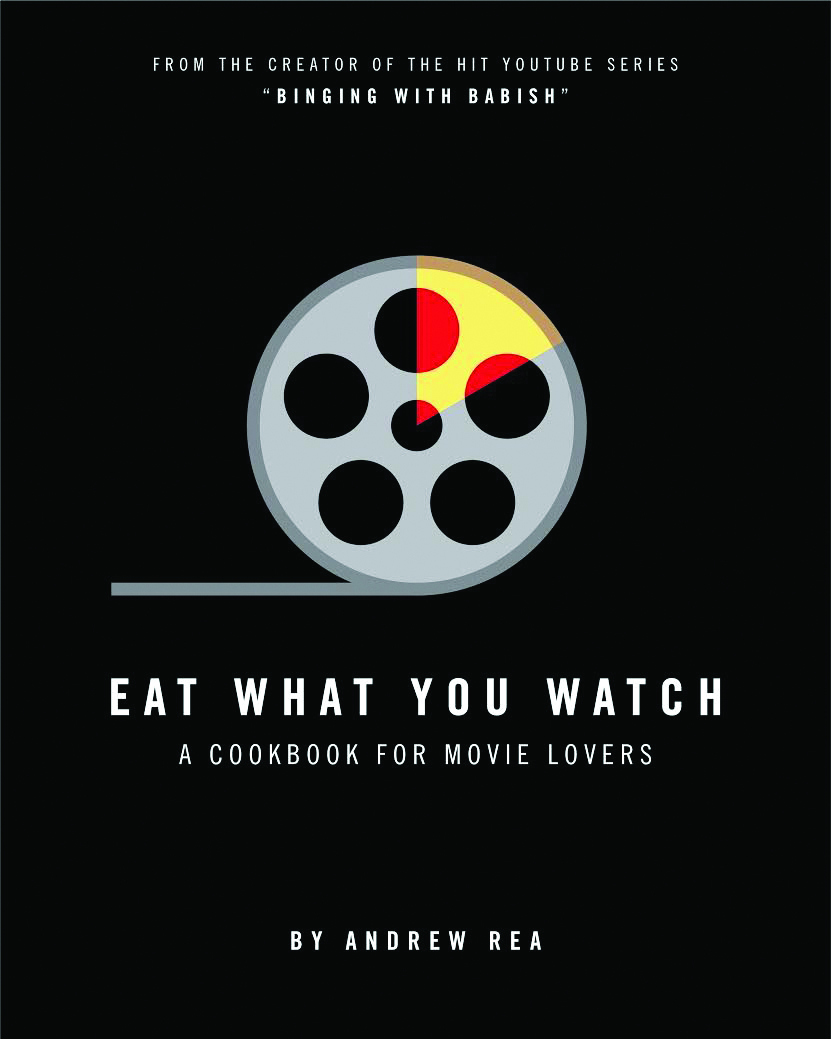
Eat What You Watch
by Andrew Rea
Recipes from more than 40 iconic movies make this the perfect gift for movie buffs and foodies alike.
Dovetail

Harry Potter: The Wand Collection
by Insight Editions
This guide fits as well on your coffee table as it does on your child’s bookshelf.
Flatiron Books
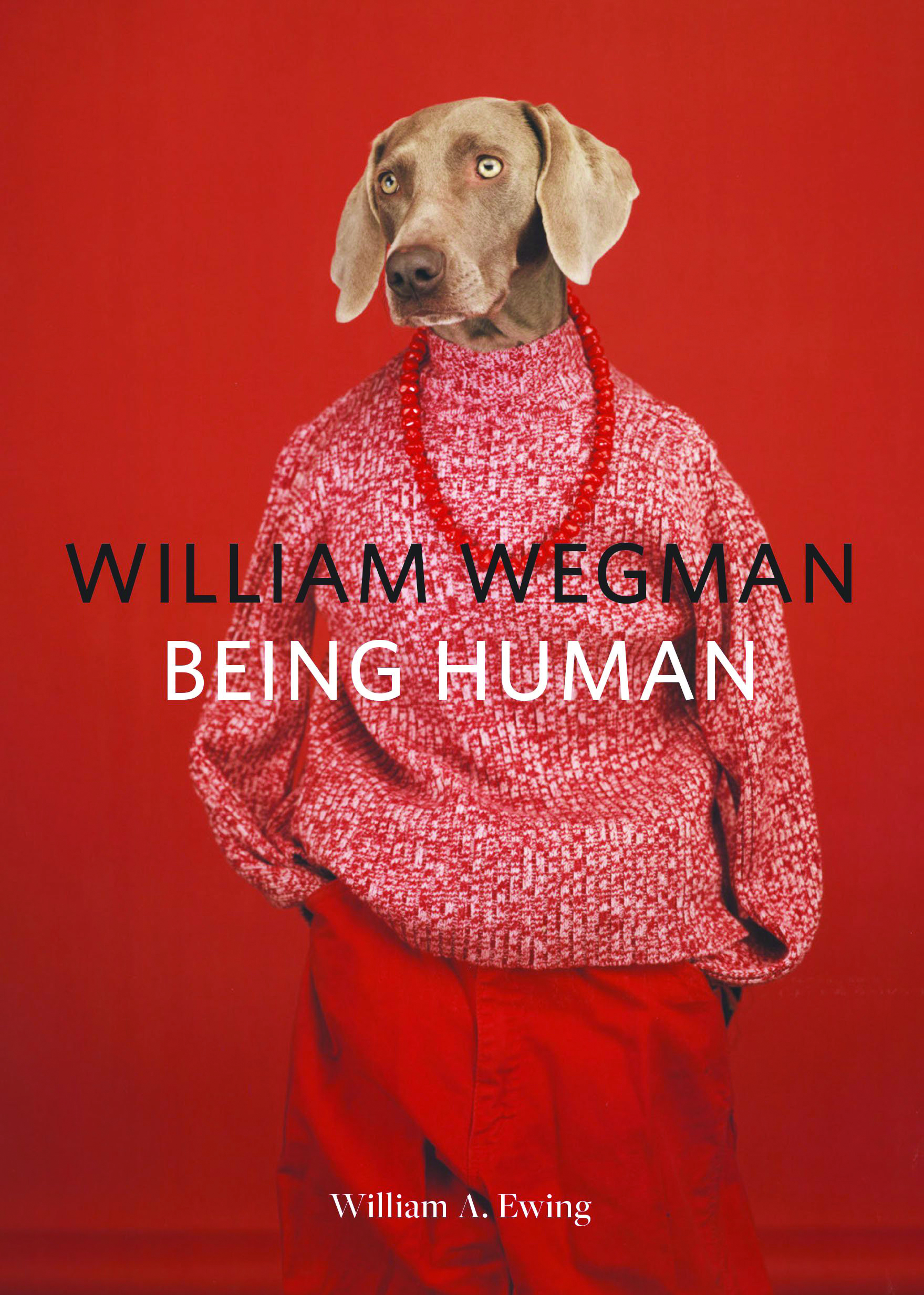
William Wegman: Being Human
by William A. Ewing
Enjoy more than 300 images from the artist’s personal archive.
Chronicle Books
This article is featured in the September/October 2017 issue of The Saturday Evening Post. Subscribe to the magazine for more art, inspiring stories, fiction, humor, and features from our archives.